


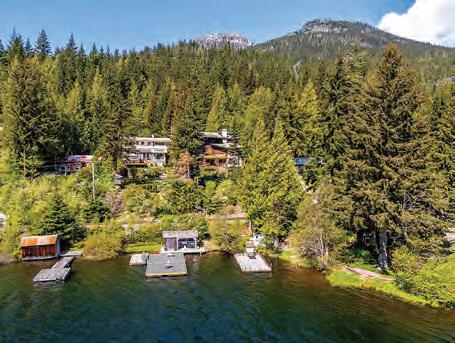
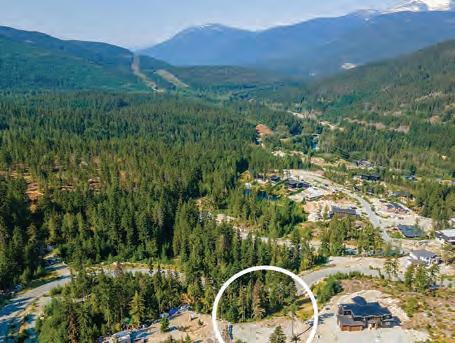



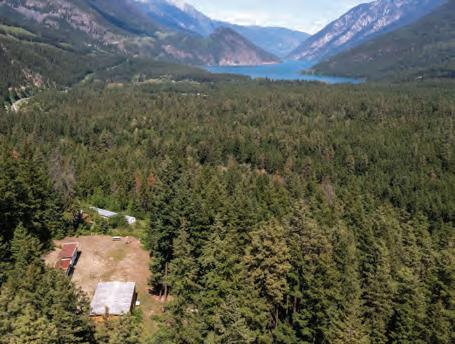
















































Is the live music scene in the Sea to Sky vibrant or dying? - By Alan Forsythe
Whether it’s trees turning red or glaciers receding, Whistler’s natural landscape is changing before our eyes, writes editor Braden Dupuis.
08 LETTERS TO THE EDITOR This week’s letter writers call for better enforcement of bike riders in Whistler Village, and weigh in on municipal dysfunction in B.C.
18 THE OUTSIDER Sonnie Trotter’s new book Uplifted is giving Vince Shuley the urge to dust off the climbing shoes and feel the freedom of rock climbing again.
PIQUE’N
In which Leslie Anthony poses “the big question”: What is wilderness, anyway?


The Resort Municipality of Whistler is investigating after several trees were illegally cut in the dead of night—right before a new tree protection bylaw was adopted.
CLOSE CALL A hiker says he is lucky to be alive after a cougar encounter on Whistler’s Singing Pass Trail.
22 COME SAIL AWAY Grade 9 students from Whistler Secondary School teamed with the Whistler Sailing Association last month to create a new outdoor classroom.
The Audain’s Gathered Leaves exhibit—considered one of the best collections of European drawings and prints in all of North America—is open now until Oct. 13.
COVER There’s nothing quite like the energy of live music, and experiencing it in a town like Whistler is truly special. - By Louise Stevens // www.lobriencreative.com
Publisher SARAH STROTHER - sstrother@piquenewsmagazine.com
Editor BRADEN DUPUIS - bdupuis@piquenewsmagazine.com
Sales Manager SUSAN HUTCHINSON - shutchinson@piquenewsmagazine.com
Production Manager AMIR SHAHRESTANI - ashahrestani@piquenewsmagazine.com
Art Director JON PARRIS - jparris@piquenewsmagazine.com
Advertising Representatives
TESSA SWEENEY - tsweeney@wplpmedia.com
ANDREW BUDRESKI - abudreski@piquenewsmagazine.com
Digital/Sales Coordinator KATIE DOUGLAS - kbechtel@wplpmedia.com
Reporters LIZ MCDONALD - emcdonald@piquenewsmagazine.com
LUKE FAULKS - lfaulks@piquenewsmagazine.com
DAVID SONG - sports@piquenewsmagazine.com
Office Manager HEIDI RODE - hrode@wplpmedia.com
Classifieds and Reception - mail@piquenewsmagazine.com
Contributors G.D. MAXWELL, GLENDA BARTOSH, LESLIE ANTHONY, ANDREW MITCHELL, ALISON TAYLOR, VINCE SHULEY, ALYSSA NOEL
Founding Publishers KATHY & BOB BARNETT www.piquenewsmagazine.com














”We must accept finite disappointment, but never lose infinite hope.” -Martin Luther King, Jr.
DISAPPOINTMENT IS a regular occurrence for all of us—but the sting of unfairness bites differently when you’re a kid. You never really forget those first big disappointments in life.
One of mine came as a very young boy, when an optometrist informed me I had a colour vision deficiency known as protanopia, meaning I sometimes have trouble differentiating between certain shades of red, green and brown.

BY BRADEN DUPUIS
After determining this, the eye doctor gravely informed me I would never be a pilot. I had never specifically wanted to be a pilot prior to that, but the disappointment
I’ve been grounded, muddling my way through an indistinguishable swirl of greens and browns ever since.
So when reports started to come in last year about the trees in Whistler turning red, I sort of just had to take everyone’s word for it.
The result of a Western spruce budworm infestation, the great reddening has (I’m told by non-colourblind sources) only continued this year, as provincial officials work with the Cheakamus Community Forest to prepare a pest management plan.
According to Kate Mitchell, a provincial forest entomologist with the Ministry of Forests, it’s not altogether unexpected. The ministry has conducted regular aerial overview surveys of B.C.’s forests since 1999, compiling decades of historical data for insect infestation, disease, wildfire—”you name it, if it’s killing or damaging trees, we’ve been mapping it for a very long
time,” Mitchell said.
Surveys would have shown a slight increase in red trees in 2023, followed by a big uptick last year, she said.
“On the Coast or even in the Southern Interior, outbreaks of Western spruce budworm are expected [about] every 20 to 25 years, and then they can persist for five or six years at a time, and then the populations kind of go down again,” she said.
More than a million hectares of forests were defoliated by Western spruce budworm this year, the vast majority—about 900,000 hectares—in the Southern Interior, Mitchell added.
It’s not unprecedented. Mitchell said the last really large outbreak occurred in 1987, and impacted 800,000 hectares of forest.
“It’s not that the ministry is not concerned … like all things which affect and potentially damage large swaths of the province, we
she said. “That’s not true. They got munched on by caterpillars, which is what turned the leaves red and caused them to fall. Next year, if the defoliators don’t come back, those are going to flush green, and no one’s ever going to know anything happened.
“Really, the way that we deal with this is just by continually monitoring it.”
As they monitor the situation, officials are also working this year on a pest management plan, complete with public engagement, should spraying Whistler’s forests become a necessity. (The Ministry of Forests was reportedly set to provide an update on July 2, after Pique’s weekly press deadline—check back next week for more.)
It can be a difficult pill for some to swallow— watching the natural world around you change, potentially irreversibly, and knowing there’s not really anything you can do but watch it happen.
account” of fresh water glaciers contain.
“Doubling the amount of water that’s lost from those glaciers, we’re sort of stealing from the future,” he said. “We are just pulling and pulling away and making that bank account closer to zero and perhaps even negative. We’re not replenishing these glaciers.”
The impact is obvious on Whistler’s glaciers. According to the Whistler Naturalists, the Wedgemount Glacier saw an average horizontal recession of 13.4 metres between 2023 and 2024. Since 1973, the glacier has receded more than 700 metres. And local researchers predict the trend will continue.
“The glacier’s retreat is a stark reminder of the environmental challenges we face. Continued monitoring efforts, now passed to a new generation, offer a glimmer of hope that we can learn from the past and work towards a more positive future for this and our other
“You name it, if it’s killing or damaging trees, we’ve been mapping it for a very long time.”
- KATE MITCHELL
obviously want to understand, contextualize and manage it where we need to,” she said, noting the Interior has had a pest management plan for decades, and regularly sprays to manage native defoliators like spruce budworm.
It’s important to note Western spruce budworm infestations, unlike other insects, don’t necessarily lead to tree mortality, Mitchell added.
“If you don’t know what you’re looking at, or you don’t think of bugs every day like we do, you might see them and go, ‘Oh my God, all these trees around Whistler are dead,’ right?’”

Disappointment doesn’t really begin to describe it. And it’s not just in the forests.
A recent study in the peer-reviewed journal Geophysical Research Letters found some glaciers in Western Canada and the U.S. lost 12 per cent of their mass from 2021 to 2024, doubling melt rates compared to the previous decade.
Canada Research Chair in glacier change and lead researcher on the study Brian Menounos told the Canadian Press climate change and its effects, including heat waves and changing snow patterns, are draining the “bank
local glaciers,” wrote the Whistler Naturalists’ Chloe Van Loon in the March instalment of Naturespeak. “Hope is not the conviction that glacier recession will slow or reverse in our lifetime, but the certainty that working to reduce our impact on the planet is the right thing to do, regardless of how our glaciers change.”
As ancient Greek philosopher Heraclitus said, the only constant in life is change. And change means new challenges, new perspectives, and yes, new disappointments. But hope springs eternal—even if we can’t necessarily see it for ourselves. n










This letter was sent to Whistler’s mayor and council, and shared with Pique.
I am writing to express significant concerns about pedestrian safety in Whistler Village following a troubling experience during my family’s visit this past weekend. My partner, daughter, our dogs and I intended to enjoy a leisurely stroll through the village, engaging in shopping and dining. However, our experience was marred by repeated safety hazards caused by mountain bikers riding through crowded pedestrian areas.
Over the course of approximately 90 minutes, we narrowly avoided collisions with cyclists on two separate occasions, with three bikers nearly striking my daughter and me. Despite clear signage instructing cyclists to dismount in the village, these rules were consistently disregarded. The lack of enforcement or reinforcement of these regulations created an unsafe and unwelcoming environment for pedestrians,

“The absence of effective bylaws or enforcement measures to ensure pedestrian safety undermines the village’s appeal as a familyfriendly destination.”
- DIANA MOGENSEN
significantly detracting from our visit.
As a family that values Whistler’s charm and vibrancy, we are deeply disappointed by this experience. The absence of effective bylaws or enforcement measures to ensure pedestrian safety undermines the village’s appeal as a family-friendly destination. Unless meaningful steps are taken to address this issue—such as increased enforcement, enhanced signage, or dedicated cyclist pathways—we will regrettably be unable to return to Whistler in the foreseeable future.
I also feel compelled to share this experience through social media to publicly raise awareness among other potential visitors.
I urge the municipal council and the Whistler Chamber to collaborate on immediate solutions to prioritize pedestrian safety and preserve Whistler’s reputation as a premier destination.
Thank you for your attention to this critical matter.
Diana Mogensen // Vancouver
Municipal dysfunction didn’t emerge in a vacuum
I read with interest Rob Shaw’s recent article on the B.C. government’s plans to rein in municipal dysfunction ( Pique , June 20). While the piece does a commendable job of highlighting the current chaos in some local councils and the province’s proposed solutions, it misses a crucial part of the story:










how we arrived at this point in the first place.
The dysfunction we’re now witnessing in municipalities across B.C. (and indeed, Canada) didn’t emerge in a vacuum. It is, in large part, the legacy of decisions made in the 1990s, when the federal government offloaded responsibility for social and affordable housing to provinces— and, by extension, to municipalities. This dramatic shift left local governments holding the bag, often without the fiscal tools or resources to address growing housing needs. The result has been decades of underinvestment, patchwork policies, and mounting pressure on municipal councils ill-equipped to solve problems that are national in scope.
public frustration—but fails to connect them to the root causes. When municipalities are tasked with solving enormous challenges like housing affordability, homelessness, and infrastructure renewal, but lack the funding and authority to do so, dysfunction is almost inevitable. The province’s proposed fixes may help, but without a frank discussion of how and why responsibility was downloaded
“The result has been decades of underinvestment, patchwork policies, and mounting pressure...”
- PETER SKEELS
The article rightly points out the symptoms—infighting, staff turnover, and
onto local governments, we risk treating the symptoms while ignoring the disease.
If we want to restore trust and effectiveness to local government, we need to talk honestly about the history of housing policy in Canada and the need for renewed federal leadership— not just new rules for councils.
Peter Skeels // Whistler n
Write to us! Letters to the editor must contain the writer’s name, address and a daytime telephone number. Maximum length is 450 words. Pique Newsmagazine reserves the right to edit, condense or refrain from publishing any contribution. Letters reflect the opinion of the writer and not that of Pique Newsmagazine. Send them to edit@ piquenewsmagazine.com before 11 a.m. on Tuesday for consideration in that week’s paper.
#303/304





NickDavies, Whistlerlocal andexperiencedfamilylawyer practisingacrossBCandYukon. Callat 604-602-9000 or visit www.macleanlaw.ca
MacleanLawisheadquartered inVancouverwithofficesacross BritishColumbia.
GreystoneLodge Skiin,skiout 2bedroomon BlackcombMountain.Enjoy greatamenities -pool, 2hot tubs,A/Cand largeowners’ storage. $1,799,000



BY LIZ MCDONALD
IN THE DAYS leading up to the Resort Municipality of Whistler (RMOW) officially adopting and implementing its new Tree Protection Bylaw, unidentified workers reportedly cut the tops off six spruce trees along the Valley Trail near Buckhorn Pond.
Buckhorn Pond is located near Alpine Meadows, within the Golden Dreams Conservation Area (GDCA), according to publicly available maps provided by the RMOW. The GDCA, a wetland habitat, was described by the municipality in a 2024 Facebook post as “one of Whistler’s largest and most important wetland complexes.”
Geographic Information System (GIS) mapping available at webmap.whistler.ca classifies the area as both “very high priority” and “high priority” for environmental protection.
The incident came to light when John Rasmussen, president of local environmental group AWARE, spoke to council on June 24 as the RMOW prepared to adopt the bylaw aimed at regulating tree removal across the municipality.
“Over four consecutive nights in the week commencing 17th of June, a team of
workers arrived at approximately 3 a.m. in the morning and proceeded to cut the top two thirds of six [spruce] trees adjacent to the Valley Trail at Buckhorn Drive,” Rasmussen told council. “I personally measured these trees this morning, and all are in excess of 30 centimetres at head height.”
“One can assume that the work of this nature, and the clandestine manner in which it was undertaken, was initiated to improve beauty for a property owner on Buckhorn Drive, and in full knowledge that it was not legal. Interestingly,
the municipality had received a treecutting complaint and that bylaw staff were investigating the matter. He said further details could not be released due to privacy concerns.
“Illegal tree-cutting is a concern, but the primary reason we passed the bylaw is because it’s good legislation. We’re proud of the bylaw. It took a lot of time and energy and effort and had a lot of input from the community,” he said.
Crompton pointed to the penalties outlined in the bylaw: a $500 fine for cutting
“One can assume that the work ... was initiated to improve beauty for a property owner on Buckhorn Drive.”
- JOHN RASMUSSEN
the site was clear of any ground visible evidence of the carnage created,” he added.
The workers were reportedly captured on a nearby security camera.
While Rasmussen said he doubted the work was done by a licensed arborist from the Sea to Sky region, he emphasized the incident as justification for council to move forward with the bylaw and prevent further unauthorized tree cutting.
Whistler Mayor Jack Crompton confirmed
trees without a permit, with a maximum fine of $50,000 per tree if the case proceeds to provincial court and results in a conviction. In this case, if prosecuted, the individual responsible could face up to $300,000 in fines.
Cutting the tops off trees—commonly referred to as “topping”—is often done by individuals concerned about tree height, typically near homes or, in this instance, allegedly to improve sightlines from a private residence. But the Arbor Day Foundation strongly advises against the practice.
“It is more than an assault on beauty; it is unnecessary stress and increased risk to the tree’s health. It is also a self-defeating exercise usually not worth the expense, and the results pose a danger from rot and weakly attached re-growth,” the foundation notes in a report available on its website.
Pegah Pourkarimi, executive director of AWARE, said the impacts go far beyond aesthetics.
“I’m presuming [cutting the top off a tree] damages it significantly. Depending on the species of tree, some of them, it could just mean the end. But it’s also what other items are impacted by that tree being lopped off at that height—the habitat for the various species, including birds,” she said.
While the loss of habitat is significant, Pourkarimi said the incident also serves as a reminder that trees are essential to human well-being.
“Protecting habitats ensures long-term survival of ecosystems and species that depend on them, but also it ensures our species’ sustainability as well,” she said. “Erosion and flooding are reduced when we keep certain trees intact around certain riparian areas or near the water, and just recognizing their role as far as our own safety is something that just needs to be driven home.”
Beyond the environmental and ecological damage, she added, the visual outcome is also striking.
“If you have a whole bunch of landscapes that look like they’ve had a buzz-cut job, it doesn’t look very good,” Pourkarimi said. n
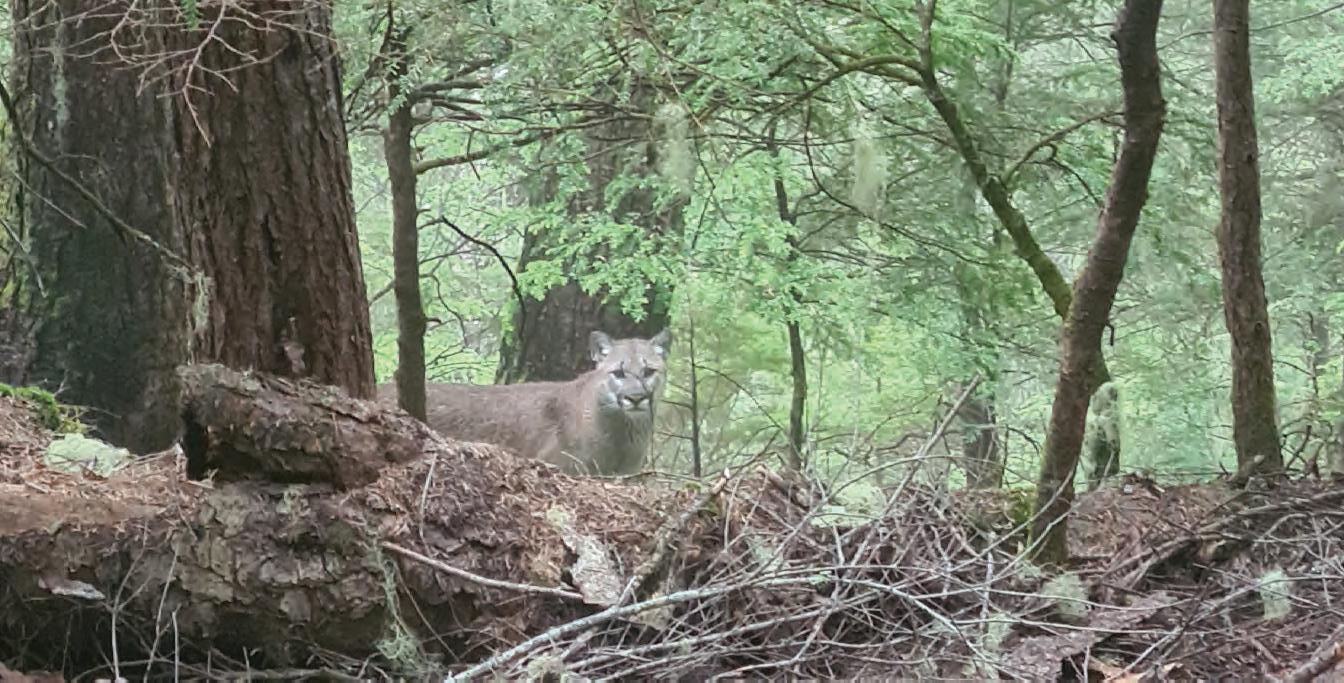
PHOTO BY ANDREW BURRIDGE
‘Lucky to be alive’: Hiker recounts cougar encounter in Whistler’s
BY BRADEN DUPUIS
HAILING FROM AUSTRALIA , Andrew Burridge is no stranger to dangerous wildlife—but a recent cougar encounter on Whistler’s Singing Pass Trail left him fearing for his life.
“Everything wants to kill you in Australia, but it’s usually quite small or is desperately trying to get away from you. So if you get killed by something, you’ve usually made some bad choices or just bad luck,” Burridge said. “But to have an apex predator lock eyes and then flank you, and then literally come at you… it’s humbling.”
An experienced hiker in Whistler for two weeks visiting his brother, Burridge made the trek up Singing Pass to the Kees and Claire hut on Tuesday, June 24.
“I was aware of the cougar sightings and the closures around the bike park and so forth. So I checked these and the trail up to the hut wasn’t closed, that section of [Garibaldi Park] wasn’t closed,” he said. “But I am not naïve … cougars move, as do all other animals. And so a mild bit of trepidation, but I didn’t feel that I was doing something silly.”
After an “unremarkable but very beautiful” hike up to the hut on Tuesday, Burridge began his descent at about 8 a.m. Wednesday, hoping to beat any inclement weather that might roll in.
About seven kilometres from the hut, he saw movement on the trail ahead.
“I immediately knew it was something big, and thought probably black bears. And then the first thing I noted was that these things moving were not black. They seemed to be brown,” he said. “I very quickly realized that it was at least one, but I thought two cougars … they were probably 30 to 50 metres ahead of me on the trail, close enough to be able to identify them, and close enough that they immediately locked eyes on to me.”
Burridge stopped dead in his tracks, hoping the cougars would move on.
In that moment, it was a sensation of “supreme beauty and feeling very lucky. Disbelief. I know they’re not seen very often,” he said. “But also, ‘oh, dear, I think I’m in trouble.’ And the more it stared, the more I thought I could be in real trouble here.”
After a very long minute or so, the cougar left the trail, but Burridge stayed on alert, not wanting to get in between a mom and its cub, or turn his back on the threat. He backtracked slowly, picking up rocks to defend himself as he went.
“And immediately after picking up the rocks, I turned to my right, which is the low side of the trail, and there’s a big adult cougar now, 10 metres, I would say, away below, so I could just see its head. Eyes locked straight onto me,” he said.
“At that point it starts running towards me. And that’s when I panicked, to an extent.”
Then, as he was backing away, Burridge lost his footing.
“I thought that I was done for,” he said. “At that point, the cougar was within touching distance, and was over me.”
Having thrown all his rocks, to little effect, Burridge was trapped.
“I tried to growl. I felt kind of embarrassed. I was actually thinking, ‘I hope no one hears this,’ which was an odd thing to be worried about at the time,” he said. “I could see the size of its paws, and I was just envisioning being disembowelled, basically.”
Then, after Burridge gave one last “visceral, gut-wrenching growl,” the cougar retreated.
“And that was just pure luck,” Burridge said. “So I got up, I backed away, and was able to carry on down the trail.”
Having heard stories about cougars stalking hikers, and still having two hours of solo hiking ahead of him, Burridge stayed on alert, but didn’t see the animals again. His















thoughts turned to the people still at the Kees and Claire hut, including three park rangers. He got in contact with the BC Conservation Officer Service to give them the heads up about his encounter.
“I was terrified, for sure. With no exaggeration, it felt this was life or death, and I was going into that fight-or-flight mode … But it was incredibly beautiful. I feel lucky,” he said.
“And I’m in cougar territory. I’m in their land, and bears as well. So I feel no ill will or like I was somehow wronged … of course, I wouldn’t want any attention to be drawn in a negative way towards any kind of wildlife. More so just the hope is that it gets people thinking … it is an actual reality, and I was literally lying on the ground with a cougar stood over me, preparing to take a swipe.”
What was going through his mind in that moment?
“I remember thinking, this is the most stunning creature I’ve seen. I remember looking and focusing on its paws as like, ‘these are huge,’ and just thinking about, ‘how do I protect my vital organs?’” he said.
“And how useless I felt—small and insignificant and defenceless.”
The other thing that will stick with Burridge is the “complete silence” of the encounter.
“That animal did not make a single
sound as it moved through the bush. I mean, when it had flanked me, I didn’t hear it. When it came towards me, it was like it was floating. It was just silent. And the next thing, it’s pretty much on top of me,” he said.
“So yeah, I felt very alone, and I was.”
Burridge sees the encounter as a good chance for all of us to reflect.
concern about the effects on these animals’ well-being and everyday lives. Even a simple thing like hiking still has impact,” he said.
“The takeaway from this is we should look out for ourselves, but in a way that recognizes that it’s an inherent and chosen risk, and it’s a beautiful thing. How lucky to have such wildlife here, in Whistler, that still exists? I’m almost amazed that it does, given
“I was terrified, for sure. With no exaggeration, it felt this was life or death, and I was going into that fightor-flight mode … But it was incredibly beautiful. I feel lucky.”
- ANDREW BURRIDGE
“[With] increased tourism, increased construction, the bike park, all of these wonderful things, those conflicts are likely to become more common,” he said. “And I still don’t see it as potentially a conflict, or that I was being attacked—quite the opposite. I was just [in the] wrong place, wrong time, in another creature’s home territory.”
With that in mind, Burridge said he wouldn’t want any harm to come to the animal.
“If anything, it just gives me pause for




1087MadeleyPlace:
$2,950,000CAD /$2,148,800USD
* Wellmaintainedhouseon quietcornerlot
*4bedrooms/2.5bathrooms, approx2,466sq.ft.
*Closetoallyear-round WhistlerResortactivities
6361FairwayDrive:
$5,380,000CAD/$3,918,800USD
*ExecutiveLogHouse,locatedin popularWhistlerCayHeights
*4bedrooms/3.5bathrooms, approx.3,200sq.ft.
*Fantasticinteriordesign& Mountainviewbalconies
Co-Listedwith: Bill Wong,RealtorSutton-Centre Realty
7601PembertonMeadowsRoad:
$1,649,000CAD/$1,201,200USD
* Wonderfulfamilyhomewith onebedroomin-lawsuite
*4bedrooms/3bathrooms, approx.3,200sq.ft.
*Mountainviews+fencedyard
KathyWhite Engeland VölkersWhistler
604-616-6933
kathy.white@evrealestate.com &


PricesinUSD$perBankofCanada &subjecttochange
the pressures in most of the world … these kinds of apex-type predators are long gone.
“So we should cherish that, and this should be a point to reflect on what we can do to support them, but also just to be sensible.”
Burridge’s encounter followed multiple incidents over the last several weeks of two
cougars acting aggressively in the Whistler area, “including chasing, stalking and being in close proximity to mountain bikers and hikers,” a COS spokesperson said. “This is unusual and concerning cougar behaviour that has led to several trail closures.”
The COS spokesperson couldn’t confirm why these cougars are acting this way, but officials believe the recent reports in Garibaldi Park and at Whistler Blackcomb pertain to the same cougars.
As of Pique ’s weekly deadline, there had been no cougar reports since Friday, June 27, though COS remains in contact with Whistler Blackcomb and BC Parks staff.
According to the provincial government, if you encounter a cougar, you should stay calm and keep the cougar in view, while picking up children immediately. Back away slowly, ensuring the animal has a clear avenue of escape.
Make yourself look as large as possible. Never run or turn your back on a cougar, as sudden movement may provoke an attack. If a cougar shows interest or follows you, respond aggressively, maintain eye contact, show your teeth and make loud noise. Arm yourself with rocks or sticks as weapons.
If a cougar attacks, fight back—convince it you are a threat and not prey, and use anything you can as a weapon, focusing your attack on the cougar’s face and eyes. Reports of cougar conflicts or aggressive cougar behaviour can be made to the RAPP line at 1-877-952-7277. n







JUDGE FINDS TWO COMPLAINANTS TO BE CREDIBLE AND RELIABLE, CONVICTING MOLINARO ON THREE COUNTS OF HISTORIC SEX CRIMES AGAINST MINORS
BY LIZ MCDONALD
PEMBERTON’S ROGER MOLINARO has been found guilty on three charges stemming from historic sexual assaults involving two girls he was once close to.
In a June 25 decision at Pemberton Provincial Court, Justice Lyndsay Smith found Molinaro guilty of one count of sexual assault and one count of sexual touching of a person under the age of 16 involving complainant Katelyn Pidperyhora. He was also convicted of one count of sexual assault against Xiola Aldrich. With their permission and the lifting of a publication ban in April 2024, Pique identified Pidperyhora and Aldrich when reporting the closing arguments.
Molinaro was acquitted on several other charges, including sexual interference, invitation to sexual touching, and additional counts of sexual assault.
“I found both witnesses to be balanced. I found them to accept differences in prior recitations of the incidents without confrontation,” Smith said, referring to the
testimonies of Aldrich and Pidperyhora.
Defence lawyer Tony Paisana argued during the trial their testimonies were inconsistent, unreliable and implausible.
Smith disagreed, noting inconsistent memory over time was “neither surprising nor material.”
In her oral ruling, Smith emphasized the longstanding relationship between the families, noting the complainants had regular and extended access to Molinaro through shared childcare duties and family friendships.
“I have, based on my consideration of the evidence, rejected the notion that [Aldrich] fabricated these allegations motivated by greed or animosity held by her against Roger Molinaro, who I find that she loved and trusted in a manner that was distorted by him by his treatment of her,” Smith said.
The defence also argued Aldrich’s mental health was a factor that undermined her credibility, which the judge rejected.
“She was candid about her mental-health challenges… She is a credible and reliable witness and I accept her evidence of being touched by Roger Molinaro,” Smith said.

PHOTO BY LIZ MCDONALD
In Aldrich’s case, the judge found sexual assaults had occurred, but said the timing of some events could not be established beyond a reasonable doubt. As a result, Smith said it would be unsafe to convict Molinaro on the remaining counts without precise evidence about when they took place.
Molinaro originally faced five charges related to Aldrich: one count each of sexual
assault, sexual touching of a person under 14, and sexual touching of a person under 16, along with two counts of invitation to sexual touching.
He also faced two charges related to Pidperyhora—one count of sexual assault and one of sexual touching of a person under 16— both of which Smith found him guilty of.
In her ruling, Smith said Pidperyhora’s testimony also showed her to be a reliable and credible witness. The judge rejected the idea Pidperyhora fabricated her claims, and found the charges “[did] not seem unlikely, unreasonable or unprobable, given the trust that was established between the families.”
At his first trial in November 2021, Molinaro was convicted on all seven counts and sentenced to five and a half years in prison in August 2022. However, his legal team successfully appealed in 2023, leading the B.C. Court of Appeal to overturn the convictions on Dec. 11. One charge resulted in an acquittal, while the remaining six were sent back for a new trial.
The matter has been adjourned to a judicial case manager, with sentencing expected to take place in Pemberton. n

BY LUKE FAULKS Local Journalism Initiative Reporter
A WHISTLER TEACHER known as much for her artistry as her academics has been named this year’s recipient of a provincial award celebrating science education. Nina Moore, a longtime teacher at the Whistler Waldorf School, was named the recipient of the 2025 Gordon Gore Prize for Excellence in Science Teaching.
For Moore, the honour was a surprise.
“I had a moment of imposter syndrome,” she admitted. “I’m a teaching generalist, not a science specialist like the high school physics or chemistry teachers.
“Then I realized—hang on a minute—I do teach an awful lot of science!”
Moore’s classroom is a hands-on playground that encourages scientific inquiry across all topics. As part of the Waldorf system’s block scheduling, Moore teaches fourweek units in areas like botany, astronomy, chemistry and physics.
“I love that I get to dip my toe in the waters of lots of different subjects,” she said.
A trained historian and artist, Moore has made a name for herself in Whistler as a face-painter, visual artist and contributor to local festivals. She told Pique her approach to
science teaching doesn’t steer away from that background.
“One of the things I love about teaching science is how it connects with human history,” she said. “When I teach ancient Egypt, we study simple machines and build models of irrigation systems. During the Roman unit, we build aqueducts and carry water around the classroom.
“So all the history I teach actually connects beautifully with the science, and I think that really helps students understand that science is something people do and feel in our everyday lives, and it has been for centuries, not something we just learn about in separation from people.”
Case in point, Moore bridged a medieval history unit and lesson on forces in a physics block by having the kids design small trebuchets and compete against each other. Her students, eager to extend the experiment, asked to scale up their trebuchets for homework.
“The next day, some kids came in with, like, one-foot models of trebuchets. One kid came in with a three-foot machine that he carried, and then the next kid’s dad was backing his truck into the playground,” she recalled.
“I actually got worried for a moment as he was backing it into Spruce Grove. I’m like, ‘Um, this is technically weaponry.’ But it was
so fun and the kids are going to remember that forever.”
That interdisciplinary flair is central to her teaching philosophy. A recent botany block had students writing poems about flowers, dyeing fabrics, crafting recipes and even concocting lavender balm.
“Art just helps them connect in a loving and beautiful way,” Moore said. “If they write a poem about a flower, they’ll remember the science behind it far better than if they just followed along in the textbook because they did something creative with it.”
Another highlight: students building Da Vinci bridges out of three-foot wooden slats and walking across a stream, drawing on lessons in Renaissance history, engineering, and problem-solving.
“And that’s another thing I think they will never forget, and they’ll be able to pull out a bridge in an emergency,” she said with a laugh.
Moore credits Waldorf’s phenomenological approach to science—starting with direct observation rather than abstract theory—with giving her space for science lessons like these.
“It keeps [students’] wonder alive,” she said. “Instead of beginning with a definition, we start with the phenomenon.
“We light a candle, the students observe it deeply, then we ask, ‘What do you see? How do
you know that?’ It builds their critical thinking from the ground up.”
The Whistler Waldorf School community is thrilled about the award.
“Waldorf education uniquely integrates the sciences with artistic and humanistic disciplines,” said principal Eleanor West in a statement. “Nina’s recognition is a reflection not only of her individual excellence, but also of our school’s commitment to offering a holistic, inspired approach to learning.”
Moore deflected some credit. “I wish all my colleagues could get awards,” she said. “They’re an awesome bunch of teachers, and I’m super grateful to them for the nomination.”
As for the prize itself, Moore is already planning to reinvest part of the $600 award into classroom equipment—but also has something sweeter in mind.
“I’m also planning a science experiment at home to celebrate by just buying like 10 different tubs of gelato and having a taste test.”
Presented annually by the BC Association of Physics Teachers, the Gore Prize recognizes a K-12 teacher who demonstrates exceptional innovation, dedication and impact in science education. Named for the late Dr. Gordon Gore—an author and educator—the award honours hands-on, dynamic teaching approaches that foster curiosity in students. n

BY ALANNA KELLY
AN ALTERCATION at a bike park in Whistler has resulted in an investigation and a person’s pass being suspended.
On June 27, a video was posted to social media showing the heated interaction at Whistler Mountain Bike Park.
A spokesperson with Vail Resorts said their team is aware of the incident.
“We have been in contact with all individuals involved,” said the spokesperson. “The safety of our guests is our top priority, and behaviour of this nature is not appropriate or acceptable in the Whistler Mountain Bike Park (WMBP).”
The video has been viewed more than 287,000 times.
In the video, three younger individuals can be seen riding and coming to a stop on a bridge to take in the view. The footage is being captured from one of their helmets.
As they come to a stop, another rider comes up beside the group, on the right.
“Sorry man, I didn’t mean it,” he said after he makes contact with the riders on the narrow bridge. He then begins to talk about fences.
He walks away with his bike but comes back towards the group and starts pushing them, claiming they called him a name.
He then picks up one of their bikes and throws it into the river.
“Bro, what the hell?” said the one person.
The young men look at each other confused.
The video shows the man continuing to yell as the three men try to de-escalate the situation and push him away.
“We don’t want to cause problems,” one of them can be heard saying. “We don’t want to fight. We are scared.”
One individual can be heard apologizing multiple times as the man keeps yelling in his face.
He shouts he’s 48 and puts his hands up to fight. He threatens that “if they do that again,” they will go in the river.
“We are sorry,” one of them said, trying to de-escalate.
The man then starts talking about a cougar in the area and warns the boys to be careful and asks one of them if they “want to go in the river with him.”
The video ends with one of them walking backwards saying they will leave.
Vail Resorts confirmed RCMP have been notified.
“We have revoked this guest’s access to the WMBP, and their pass has been suspended,” said the spokesperson. “We are committed to upholding a safe and respectful environment for all guests in our park.”
Pique reached out to RCMP but did not receive a response before press time.
As Whistler’s trails once again fill up with bikes, local police say they are planning a “no-tolerance approach” to helmetless riders this summer.
According to a release from the Whistler RCMP, the local detachment typically receives an increase in complaints related to cyclists riding without helmets at this time of year.
“It is the law in B.C. that helmets must be worn when operating or riding as a passenger on a bicycle, and it is the law that a parent cannot allow a child under 16 to operate a bicycle without a helmet,” said Whistler RCMP Cpl. John Pellegrino in the release. “The penalties for these offences are not high, but a dollar value cannot be placed on the physical and emotional impact of an injury or death as a result of not wearing a helmet.”

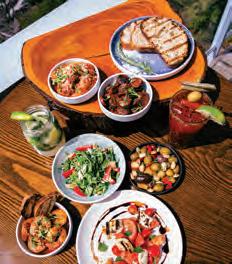



With that in mind, local police will conduct “bicycle helmet compliance reminders” in the weeks ahead, in the hopes of hammering home the safety message.
“Commencing July 1, the Whistler RCMP will be taking a no-tolerance approach to bicycle riders and passengers who are not wearing helmets, issuing violation tickets to those who are not in compliance,” the release said.
“While this is a very serious topic, there is good news! The Whistler RCMP has connected with a number of Whistler’s community businesses who wish to partner with the RCMP in the initiative to keep our local cyclers safe. If you are the unlucky recipient of a violation ticket for not wearing a helmet, you can take your violation ticket to a number of local shops and receive a discount on the purchase of a bicycle helmet.”
The participating partners include: Surefoot Whistler; Gateway Bikes / Whistler Sports Rentals Ltd; Arbutus Routes; Mountain Rentals; Fanatik Co; Comor Whistler; and Evolution Whistler.
Whistler businesses who would like to partner with the Whistler RCMP on the initiative can contact Pellegrino at the Whistler RCMP Detachment at 604-932-3044.
-Braden Dupuis n

THE COLLABORATIVE PROJECT BLENDS CUTTING-EDGE TECHNOLOGY WITH INDIGENOUS KNOWLEDGE TO PROTECT CULTURAL HERITAGE AND INSPIRE THE NEXT GENERATION OF ARCHEOLOGISTS
BY LUKE FAULKS
Local Journalism Initiative Reporter
NEAR THE BAILEY BRIDGE, about 10 minutes up the road from Mount Currie, archeologists and Lil’wat Nation community members are reshaping what collaborative research can look like.
For nearly two decades, Douglas College anthropology instructor Bill Angelbeck has worked alongside the Nation to investigate ancient village sites, often focusing on winter homes known as s7ístken (pronounced “ishkin”)—underground dwellings or “pit houses” traditionally used during winter.
Angelbeck and a team of students and volunteer archeologists have just completed a three-week dig as part of a multi-year project that’s working to use archeology and oral history in tandem to create a unified narrative for the Nation.
“We called it ‘interweaving narratives,’” Angelbeck explained to Pique
“I see science as producing narratives just with scientific language. Just like oral tradition, [science is] subject to interpretation, and subject to refined understandings over time. We have scientific narratives about the history, and we also have oral history. How do we interweave those together?”
Lil’wat Land and Title Department coordinator Xzúmalus Roxanne Joe is excited
about the proposition.
“We say that we’ve been here since time immemorial, and now this is giving science to point to specific dates,” Xzúmalus told a group of visitors to this year’s dig site.
The project, a partnership between Douglas College’s anthropology department and Lil’wat Title and Rights, has grown from modest beginnings. Angelbeck has worked with the Nation since 2006, when he met Lil’wat archeologist and cultural technician Johnny Jones.
The work on their current project, Interweaving narratives: integrating oral histories with archeological investigations in Lil’wat territory, began in earnest in 2015, funded by an internal grant and focused on documentation of sites identified by Lil’wat knowledge holders. The team has carried out 10 archeological investigations on the territory, dating sites as ancient as 5,500 years old.
The current phase of the research is supported by a three-year, $360,000 federal grant that allows Angelbeck and the Nation to pursue more extensive investigations using cuttingedge technology. The team has employed both LiDAR—Light Detection and Ranging—and ground-penetrating radar (GPR) to uncover buried features across the landscape.
LiDAR uses laser pulses emitted from drones to strip away the forest canopy and reveal subtle depressions and elevations. The technology has been used worldwide to map sites obscured by dense vegetation, including Mayan temples and settlements in Central America.
“LiDAR sends millions of laser points per second,” explained Douglas geography lab technician Sasha Djakovic, who pilots a $40,000 LiDAR drone for the research time.
“When we strip the trees away in the post-processing, we’re left with a digital elevation model. Even changes in elevation of 20 centimetres will show up and point us towards village sites.”
Using the LiDAR technology has allowed the team to generate detailed 3D surface maps of excavation sites and create a database of old village sites in Ucwalmícwts, the Nation’s traditional language.
After a LiDAR drone has mapped the terrain from the air, GPR allows archeologists to peer beneath the ground’s surface. Using a device resembling a lawnmower, the team pushes the GPR unit over depressions that might indicate housepits to detect anomalies—subsurface features that stand out from the surrounding soil, like rock clusters, charcoal deposits and remnants of wooden beams.
The Bailey Bridge West site has been a focal point. The team uncovered 13 s7ístken at the site, including a 15-by-15-metre housepit— the largest yet identified in Lil’wat territory. They’ve dated some s7ístken at 1,700 years old and others at 2,700.
Each s7ístken contains different artifacts; from arrowheads with the Lil’wat Nation’s signature tang—an extra hook towards the bottom of the arrow—to beads and hearths and even the remnants of the pit-house roofs.
“That’s huge,” Angelbeck said of the findings. “Sometimes we put [excavation] units in and miss everything. It’s dispiriting
for people who’ve volunteered a week of their time. But this time, every unit hit something.”
Xzúmalus has worked on the project since 2021. She emphasized its growing inclusivity. This year, with the dig running longer thanks to unprecedented grant funding, local students were able to visit the site and ask questions of Angelbeck’s team—with many expressing interest in pursuing archeology themselves.
For the last decade, Angelbeck’s team has included young Lil’wat Nation member Talon Pascal. Pascal first started volunteering on the site when he was 12, after Johnny Jones told his mom about Angelbeck’s dig.
He’s since grown into one of the crew’s most experienced members.
“He was always finding the arrowheads,” Angelbeck recalled. “He’s a flintknapper now and has made his own pit house and canoe.”
Pascal’s personal journey embodies the community-led approach the project is taking. His detailed knowledge of the territory, the lithic traditions and his connection to the land have made him a key contributor, said Angelbeck.
The project’s deeper aim is to challenge conventional archeological practices that have historically extracted Indigenous knowledge and artifacts without consent or benefit to Indigenous communities.
Historically, some archeological digs or anthropological ethnographies conducted on Indigenous territory treat findings as
THE CHARITY ARM OF BC PARKS IS LOOKING TO RAISE $2.6M BY JULY 15 TO CREATE A PROTECTED GRIZZLY HABITAT
BY LUKE FAULKS
Local Journalism Initiative Reporter
THE BC PARKS Foundation (BCPF) is looking to purchase a 46.5-hectare property in Pemberton Meadows to support recovery efforts for one of British Columbia’s most endangered grizzly bear populations.
The foundation has identified DL 813 Pemberton Meadows Road as a key parcel that could provide safe habitat and critical foraging ground for the Stein–Nahatlatch grizzly bear population unit—a genetically isolated group with fewer than 20 individuals remaining.
“Many grizzly populations at the southern edge of their range in B.C. are under threat, but the population in southwestern B.C. is at risk of dying out,” said Coast to Cascades (C2C)’s Michelle McLellan on the BCPF’s website. “We need to protect the places that connect populations so they survive, and that means people stepping up to make a difference.”
BCPF is campaigning to raise $2.6 million by July 15 to purchase the property. So far, they’ve raised just over half the money needed.
If the purchase goes through, the BC Parks Foundation told Pique they plan to develop a work in partnership with local community groups to address wildlife needs, access and safety. Their stewardship plan
includes restoring native plant species and berry-producing shrubs essential to grizzly bear diets.
The vacant, riverside, organic farmland property in question lies at the intersection of two threatened grizzly bear population units, the Squamish-Lillooet and South Chilcotin, and supports efforts to protect the critically endangered Stein-Nahatlatch population.
According to the C2C, the Stein–Nahatlatch grizzly population, whose territory is “bounded by the Fraser River, Lillooet and Harrison Lakes and capped by the Duffy Lake portion of Highway 99 and Anderson and Seton Lakes,” is critically endangered with limited genetic diversity and only about six breeding females remaining.
Habitat fragmentation, motorized recreation and backcountry road access have accelerated the decline of the population. C2C warns without targeted conservation efforts, the Stein–Nahatlatch grizzlies could vanish within a few generations.
If successful, the Foundation’s acquisition would contribute to a growing “parks bank” initiative, securing land to support biodiversity and climate resilience across British Columbia.
You can learn more about the campaign and donate to the effort on the BC Parks Foundation’s website. n
LIL’WAT ARCHEOLOGY FROM PAGE 16
the intellectual property of the researchers, rather than belonging to the host Nation. Angelbeck cited particularly egregious examples of researchers demanding compensation for First Nations seeking transcripts from elder interviews.
The Douglas team is working to counter those practices.
“All the data we collect is Lil’wat’s first,” Djakovic emphasized during a presentation. “We use it for research, but only under their guidance. Finding sites is tricky—we don’t always know where they are—but we’re working to connect the known villages, and we’re doing that on [Lil’wat’s] terms.”
The partnership’s success has rippled outward.
New sites identified through LiDAR are now officially registered with the provincial archeology branch, granting them protection from logging and resource extraction. Xzúmalus also noted the archeological record—combined with Lil’wat oral histories— is increasingly powerful in land claim efforts.
The Nation is not simply a stakeholder in the project—they’re co-leaders. Their oral histories help guide where the digs take place. Their knowledge informs the excavation strategy. And their priorities

The RMOW is seeking winter-themed submissions for the Lamppost Banner Program.
The awarded artist will be featured on lampposts throughout Whistler for the 2025 and 2026 winter seasons.
Submissions are open through Thursday, July 31, 2025.



THURSDAY,July10,2025 @7:00pm 7390CottonwoodStreet,Pemberton,BC
shape the project’s next steps.
Lhpatq Maxine Bruce, who participated in a site visit, stressed the urgency of continuing the work while the community’s elders are still able to share their knowledge.
“I hear a lot of denialism about Indigenous people,” Lhpatq said. “It’s exciting you’ve taken on this kind of project, but the selfish part of me says: move faster. We don’t have very many elders left.”
The next phase of the project will focus heavily on oral history interviews. Angelbeck’s team has secured the necessary permits from the Lil’wat Nation and the provincial archeology branch to investigate additional sites identified through LiDAR. But the priority is to preserve the stories.
“One of the elders working with us has his own notebook of recorded stories,” Angelbeck said. “He’s very protective of it. Some stories can be shared, and some can’t.”
The careful stewardship of these histories stands in sharp contrast to the extractive or performative models archeology has often followed in the past.
“Sometimes archeological assessments are just a checkbox in a development process,” Angelbeck said. “But here, the goal is not to enable a project to go forward— it’s to enrich Lil’wat’s own story, to protect what’s there and to ensure the work is done in a way that centres Lil’wat priorities.” n
The PembertonValleyDykingDistrict(PVDD)willbeholdingits78thAnnualGeneral Meeting,andyouareinvitedto attendthisevent. Youwillgain agreat overviewofwhat the PVDDdoes,seewhat projectshavebeencompletedandwhat projectsareinprogress for2025/2026.
AttheThursday,July10,2025AGM,thePVDDwillbeelectingtwoTrusteestotheBoardfor atermofapproximately3 years– termsendonthedateoftheelectionheldinthe3rd year. LandownerstoalsoapproveTrusteehonorarium at thismeeting.
VoterEligibility:(IDmustbepresented)
Onlypersonsattendingtheelectionandmeetingthefollowingeligibility requirementsareentitledtovote:
•A CanadianCitizen.
•Eighteenyearsofage,orolder.
•AnowneroflandwithinthePemberton ValleyDykingDistrictboundaries.
•A residentoftheprovinceofBritishColumbiaforthepriorsixmonths.
•A legalrepresentativeofanowneroflandwithinthePemberton ValleyDyking Districtboundaries.
•Anauthorizedagentof acorporationorboardthatownslandwithinthe Pemberton ValleyDykingDistrictboundaries.A letterwrittenoncompany letterheadmustbe deliveredtotheReturningOfficer,bytheauthorized agent,beforetheelectionbegins. Thatauthorizedagentmustalsosign aStatutory DeclarationFormpriortovoting.
TrusteeEligibility:
•Every personwhoisqualifiedtobeanelectorisalsoqualifiedtobea Trustee.
•Thespouseof aqualifiedelectormayalsoholdtheofficeof Trustee.
Forfurtherdetails,pleasegoontothe Pemberton ValleyDykingDistrict’s website:www.pvdd.ca PembertonValleyDykingDistrict POBox235 Pemberton,B.C.V0N2L0
Phone:(604)894-6632Fax:(604)894-5271
Email:trustees@pvdd.ca

ROCK CLIMBING is one of those sports that when you hit a certain level, things can get rather intimidating. The first time I ever lead climbed on “trad gear” (placing removable fall protection on the rock as you climb) I was

BY VINCE SHULEY
terrified, the consequences of falling suddenly getting all the more real. What surprised me during this stressful foray into trad climbing was the amount of strength and focus I didn’t know I had. But that strength and focus had a limit, my risk tolerance overriding my desire to push into bigger, harder climbs.
When I watch climbing documentaries about Alex Honnold (Free Solo) or the late MarcAndré Leclerc (The Alpinist), I don’t really see much of myself in these athletes. Their skill, work ethic, and tolerance of risk seem almost otherworldly. When you see these men getting interviewed on camera, their mannerisms and perspectives paint them as a different type of
POWER LIFT Sonnie Trotter’s new book Uplifted: The evolution of a climbing life documents the Canadian’s 30-year climbing career. Trotter is seen here traversing on the first free ascent of Pineapple Express (5.13) in Yosemite National Park with climbing partner and friend Tommy Caldwell belaying attentively.
human altogether.
That wasn’t the case when I read Sonnie Trotter’s new book Uplifted: The evolution of a climbing life. For those not familiar, Trotter is a Canadian professional climber who has spent his 30-year career contributing to hundreds of first free ascents around the world (free ascent is climbing a wall without any artificial aid, not to be confused with free solo ascent, which is
up to 14 hours a day to fund the next climbing trip, when cashing a paycheck Trotter was asked by his bank if he was interested in taking out a line of credit for $20,000. While the idea of being indebted was scary, the opportunity it represented was far more powerful. A month later, Trotter quit his job, withdrew half his credit limit and bought a van. Filling the vehicle with his climbing pack, a duffle of wrinkly clothes, a
“I was determined to live the life I had always dreamt of, to climb every day, to meet like-minded people, and to experience as many new routes and rock types as my time on this planet would allow. Nothing else mattered.”
- SONNIE TROTTER
climbing without any protection at all and what Honnold and Leclerc are known for). Trotter’s list of accomplishments rival any climber in the sport, but his story of getting there is one that is so much more relatable. From growing up in Newmarket, Ont., and finding his place at a local climbing gym as a restless teenager, to making the difficult decision to turn around on what might end up being a once-in-a-lifetime climbing opportunity, the tales of his life in Uplifted seem all the more, well, human.
The part of Trotter’s story I related to most was his period of going “all in” on his climbing career. Twenty-three years old and banging nails
cheap sleeping bag and enough canned food and pasta to feed him for a month, Trotter pointed his wheels towards Colorado and embraced a new type of climbing freedom.
While I’ve never gone full van-life with the aim of climbing every day, committing to a modest mountain lifestyle requires a similar leap. You could probably make more money pursuing a career back in your hometown or a big city, but the opportunity to live with adventure on your doorstep—every single day—is one that’s simply too good to pass up. For Trotter, that line of credit let him focus solely on climbing for the next year to see if he could make this adventurous lifestyle
work, and maybe even scrape through with a career as a pro climber.
“Fuck it,” he wrote in Uplifted. “I knew what I was doing—even if the bank didn’t. I was determined to live the life I had always dreamt of, to climb every day, to meet like-minded people, and to experience as many new routes and rock types as my time on this planet would allow. Nothing else mattered.”
Those first 18 months led to Trotter’s first real recognition for his pioneering climbs. It also led to conversations with the outdoor brand Patagonia and eventually a career-long partnership. Since then, Trotter unlocked new free ascent routes everywhere from Squamish and the Canadian Rockies to Mexico’s Cascada de Basaseachi National Park. He has climbed with the world’s best athletes, written stories about truly exotic locations (with photos to match, many of which appear in his book) and perhaps most impressively, has managed a successful pro-climbing career while prioritizing family life with two children. In a sport where climbers and mountaineers often perish in the pursuit of greatness, Trotter’s approach to risk in the mountains has evolved with his experience.
Does Uplifted make me want a send a 5.13? Not really. I know what I’m capable of and I don’t need that level of stress. But the book does make me want to dust off the climbing shoes and feel the freedom of rock climbing again.
Well done, Sonnie.
Uplifted: The evolution of a climbing life is published by Patagonia and is now available in hardcover. For questions, comments or suggestions for The Outsider, email vince. shuley@gmail.com or Instagram @whis_vince. n


Drawings from the National Gallery of Canada’s Vault
Two nights. One extraordinary experience.
Enjoy an exclusive after-hours tour featuring works by Pablo Picasso, Edgar Degas, and Edvard Munch followed by an artfully prepared four-course menu.
Dinner PartnerWine PartnerBeverage Partner




July 18 & August 29
From $199 per person


Is the live music scene in the Sea to Sky vibrant or dying?
BY ALAN FORSYTHE
Whistler is a resort town, and that means there are going to be bars, parties, celebrations and live music. But has the live music scene morphed into the DJ scene? Do people just go out less? What’s the deal here—are we getting boring?
NOT ACCORDING TO Doug Craig, one half of legendary Sea to Sky band, The Hairfarmers.
“The music scene, specifically in Whistler, has changed somewhat in that there are a lot more people here, and with a lot more distractions,” Craig says. “Including phones and electronic media, people seem more entertained than ever, and live music is just another option.”
The other half of The Hairfarmers, Greg Reamsbottom, echoes his bandmate’s sentiment.
“Bands come and go. Venues come and go, or change direction,” he says. “Venue managers come and go, and have different ideas of what type of entertainment they should offer their clients, and have different ideas of what their budgets should be for hiring bands and/or DJs. The music scene is always changing in some ways, but we are always busy—that hasn’t changed.”
Tom Csima, part of the four-piece band The Zummers (winners of the 2024 Whistler Music Search and Squamish’s 2025 Battle of the Bands) says while people still do appreciate live music, finding venues for a full band can be a challenge sometimes.
“As a solo artist, there are definitely more options to play at restaurants and bars all over,” Csima says. “As a band, it is definitely more challenging, especially as we play loud and almost entirely original music.”
But both bands and solo acts need more options, says Casper Nova, who handles the door and helps promote and organize venues for bands up and down the Sea to Sky corridor.
“It’s a struggle for some musicians to access venues here,” Nova says. “It’s great that the Olympic Plaza has reached out and created a venue for artists [through the Whistler Summer Concert Series]. Although my preference would be not to have it so centralized. I like the more back-and-forth engagement of smaller venues. I think they should make it easier for little cafés to support singer/songwriters and smaller bands, allowing them to play at different hours than they’re usually open.
“A diversity of spaces is what I prefer, even busking. I think it’s ridiculous you need a permit to busk. It should be considered an attraction. Share the wealth and creativity.”
Kevin Wood and Martini Bart, owners of the recently renovated Alpine Café, have been doing just what Nova advocates for, supporting local music to the best of their ability since opening in 2003.
“From our perspective, we just provide a platform for musicians to get up and perform,” Wood says. “It’s a community hub up here in
Alpine. Obviously we’re not a music venue, we just try to promote local musicians.”
He says he and his partner Bart once discussed charging people at the door, but decided that would become too complicated.
“If local musicians want to get up and play, we provide that platform. Sometimes it’s their first exposure; we had a band down from Pemberton last week, it was the first time they played live,” says Wood. But the Alpine Café doesn’t book acts, he stresses.
“It’s how we make it work for us,” he says. “We don’t pay, we just offer a dinner. And that’s how we grew—locals get to come in and see local talent.”
Kostas Lymbertos—better known as Kostaman—has been playing live in Whistler for more than 25 years, and was the host of several long-running open-mic nights in the resort.
He says live music and life in Whistler have gone hand-in-hand from Day 1.
“Since my first week in Whistler, I’ve been playing music as a way of life. I received lots of love and met the world,” Kostaman says. He credits Wood and Bart at Alpine Café for keeping him inspired. “I’m so grateful to have a wonderful, truly local stage to play at the Alpine Café—it is the reason I’m still in Whistler,” he says.
Bart says Kostaman, who has been playing at the Alpine Café almost from the beginning, has become sort of their house band.
“Last New Year’s Eve, we didn’t know Kostas would be here or not, but he just came in, and it turned into a big party,” he says, speaking to the spontaneous, organic quality that shapes a lot of local music.
“We can’t be like the village and charge $100 for an event on a big night like NYE, it has to just happen.”
Some would say impromptu live music was a bigger part of Whistler “back in the day” when the resort was less established.
“When I first heard about the music scene in Whistler I was a bouncer at a nightclub in Edmonton, and one of the guys who came in to play was Rob McQuaid (longtime Whistler solo act), and he told me about the music scene going on in Whistler, and that Brandy’s at The Keg was the place where people went for live music—that was back in 1987,” says Craig about his entry into the Whistler music scene.
“In the late ‘80s I got to Whistler, and as I was parking, Johnny Thrash (writer/ski bum/ punk rocker) came up and told me about a jam night happening at Citta’s. I ended up playing there and hosting that jam night for the next two years. Also I played at The Boot, and hosted that jam night for three years as

well—there were plenty of places to play.”
When asked if starting a band would be more difficult today, Reamsbottom says he really has no idea, since it’s been 25 years since he started a new band. But, he figures, the formula to success (or at least surviving at it) likely hasn’t changed since.
“If you can put on a show that truly resonates with people, and if you behave like a professional, and have any business sense at all, with a little luck, and a lot of hard work, you should be able to pull it off, and the people will come, and your band will be busy,” Reamsbottom says.
Csima, whose experience with starting a band is a lot more recent, says it’s not as challenging as some might think.
“It wasn’t that hard, to be honest, if you’re really trying,” he says. “The bigger challenge is finding a place to practise/play/store your gear.”
Of course, today we have social media, something that wasn’t a factor 25 years ago. Has that helped local musicians get more recognition?
“I never had Instagram until I started The Zummers, so I’m a bit of a newbie with it, though luckily my bandmates all chip in,” says Csima.
“Unfortunately the reality is it is an absolute necessity, and takes a huge amount of time and effort. I can see from other bands that we follow how important it is to regularly post content and engage with your audience. I can also see after every show we play the boost in ‘likes’ and ‘follows’ we get.”
Craig is no stranger to social media, either, but sees it as just another marketing tool.
“While social media can be a valuable tool for reaching a wider audience, it’s not a guaranteed path to increased engagement or sales, and it’s not a standalone solution,”
Craig says, adding at the end of the day, the best marketing is a good performance.
“The Hairfarmers have always had an underground following and we will continue to expand our audience by wordof-mouth,” he says. “We are known for our sense of humour and just creating a really fun atmosphere at the shows.”
Is appreciation for live music growing or declining? According to Csima, it depends where you are.
“In the Sea to Sky, I wouldn’t say it is growing. There are definitely more opportunities to play than there were a few years ago, during and after COVID. But I find DJs seem to be playing more of the bigger shows and in many cases have better turnouts than live bands,” he says. “We do get a lot of feedback at our shows though, from excited music fans showing their appreciation and commenting on the lack of new original music locally.”
DJ culture has certainly taken over a lot of ground that used to be the domain of live bands, but Reamsbottom says it comes down to who can provide the best entertainment.
“There’s room for both, and in some entertainment situations a DJ is better suited to the event,” he says. “If what your band does can be replaced by a DJ then you have to change what your band is doing.”
Craig adds he fully supports the DJ scene in Whistler, and even DJs himself between sets where the Hairfarmers are playing.
With all the talent in Whistler and the Sea to Sky corridor, it does seem surprising there isn’t a large music festival in the area, along the lines of the Coachella Valley Music and Arts Festival, in southern California. Although


NINTH-GRADERS HELPED SAILING CLUB MEMBERS IMPROVE THEIR WATERFRONT WHILE LEARNING TO SAIL
BY DAVID SONG
TWO GRADE 9 CLASSES from Whistler Secondary School (WSS) rolled up their sleeves earlier in June and—under the supervision of phys-ed teacher Peter Train—helped the Whistler Sailing Association (WSA) create a new outdoor classroom.
By clearing out invasive plants, hauling out debris and levelling ground, the students transformed a section of the WSA waterfront. Now the previously underutilized area may accommodate instructors as they teach sailing theory, weather, safety, and environmental awareness by the water without needing improvised setups.
In return for their hard work, WSA general manager Francois Hebert guided the youngsters through beginner sailing lessons where they learned how to steer a boat, adjust sails, read wind direction and keep themselves safe. A capsize drill, where kids intentionally tipped their craft to practice recovering it, formed a key part of the experience.
“[The outdoor classroom] adds tremendous
value to our programming, especially for schools and larger youth groups. As our programs continue to grow, having this dedicated outdoor classroom also gives us much-needed additional space to support that expansion,” Hebert said. “The sailing centre belongs to the community, as it is located on Resort Municipality of Whistler property. Whistler Sailing is a nonprofit organization dedicated to making sailing accessible and affordable for people of all ages and backgrounds.
“Our focus is on community access, reducing barriers to entry, and providing inclusive programs that connect youth and families with the water in a fun and welcoming environment.”
WSA members originally envisioned building a deck in the space they wanted to develop, but the Resort Municipality of Whistler (RMOW) did not support that idea. Meanwhile, the idea of full-day sailing field trips with WSS fell through due to a lack of funding.
Hebert and Train decided on a novel solution: time on the water in exchange for student help in landscaping the site—which cannot be accessed by machinery like tractors or excavators due to the presence of a nearby railroad track.
‘STONE BY STONE, WITH PURPOSE’
The collaboration materialized “with great
enthusiasm,” according to Hebert. A trio of WSA staff and a volunteer helped direct the students, while board member Mick Gannon planned the new site’s layout and brought in necessary tools like rakes, shovels, saws and wheelbarrows. Gannon’s laser level coordinated efforts by both classes, ensuring the area had a two-per-cent slope towards the lake for proper drainage.
Train also played a central role in scheduling, supervising his pupils and making sure the project aligned with WSS educational goals.
“WSA has had a long-term relationship with Peter. He loved the idea of the community project I suggested and he was very supportive from the start,” Hebert remarked. “His calm presence, steady guidance, and way of keeping students engaged helped everything run smoothly. He really connected the dots between the idea and making it happen. He even gave us a crash course in proper rock wall building, complete with classic U.K. technique: think ‘stone by stone with purpose.’ He was right there with us, handson, getting dirt under his nails and helping every step of the way.”
Each class encompassed 25 students, who combined for a total of 100 volunteer hours (two per person). Many had never been on a sailboat before, but responded favourably to instruction. As the group’s confidence increased, some expressed interest in taking additional lessons or summer programming.
“The student response was amazing, which came as a bit of a relief. I wasn’t sure how interested they’d be in the physical work or whether they’d connect with the experience at all … but they jumped in with energy, took pride in the project and really embraced the whole process,” Hebert recalled. “I think some of them enjoyed hauling gravel and moving dirt just as much as, if not more than, the sailing itself.
“There was something incredibly rewarding about seeing that much progress happen so quickly, just from everyone working together. It was a big change from their usual classroom routine and they totally got into it. At one point, kids were literally running with wheelbarrows like it was a race.
The energy was contagious.”
WSA board members and volunteers raised more than $13,000 alongside their community to facilitate the outdoor classroom undertaking. Remaining funds will go towards installing whiteboards for instruction, building a sail storage shed for improved organization and adding a shade sail to provide shelter. Hebert expects the classroom to be ready in the coming weeks, just as WSA’s youth summer camps launch.
The 2023 ILCA7 Laser Master Sailboat champ sees a great deal of value in giving Whistler’s teenagers a chance to acquire new skills and mould their community. He hopes to begin an annual tradition of work projects with WSS going forward. n



BY DAVID SONG
HUSTLE BASKETBALL, formerly known as Hoop Reel, is ramping up efforts to provide Sea to Sky youngsters with comprehensive athletic development. That›s why they brought in Mike Nuga for an early June day camp.
Nuga signed with the Vancouver Bandits of the Canadian Elite Basketball League (CEBL) in April. The 6-2 point guard averaged 11.4 points, 1.8 rebounds and 1.8 assists in 17 games as a member of the Edmonton Stingers last year, and is a friend of Hustle head coach Bo Banner.
Two sessions were offered: one for kids aged six to 10 and another for teenagers in the 13 to 17 age bracket. One lucky camper received a signed pair of shoes from Nuga, who came away impressed with the dedication of all who participated.
“Being someone who’s run many camps, I know Whistler is small and it may not have the biggest basketball community, but just seeing the actual love for the game—I was very happy,” he said. “The kids worked hard. They listened very well. Everyone was attentive and they wanted to get better. It’s not just [parents going], ‘oh, let’s send our kids to a program and let them play for a couple hours.’ I saw it in their eyes: this was a bunch of kids that actually enjoy the sport.”
Nuga’s goal as a coach is to make sure his pupils learn and enjoy themselves. Basketball, like any sport, can teach its players work ethic while granting an opportunity to make connections on and off the floor—but these benefits must be earned.
“I always let the kids know that anything in life you’re going to take seriously, it’s not going to be easy,” he said. “But the rewards, if you take it seriously, will always outweigh the obstacles. I just let them know that if [basketball] is something you’re serious about, the challenges are only going to make you

better … stronger, smarter and able to help other people even more.”
Nuga understands what it’s like to take the road less travelled: born as he was in Lagos, Nigeria and raised in Scarborough, Ont. While most young hoopers fantasize about March Madness glory and a lucrative NBA career, he paid his dues at Eastern Florida State College—helping them to an NJCAA Finals appearance in 2017 before transferring up to the NCAA Division I level.
Campaigns at Portland State University, Kent State University and the University of Nevada, Las Vegas (UNLV) followed, but Nuga’s name wouldn’t be called by any NBA franchise on draft day. Instead he travelled overseas to play in Spain, Kosovo and Latvia in addition to his CEBL career, and he takes all those frequent flyer miles in stride.
“I’m so early in my career and I know there’s so many more places to discover, so many more cultures that I’m going to learn,” Nuga remarked. “It just teaches me to be grateful. Basketball is taking me literally all over the world. Every time I get on that court … I feel like I would be doing a disservice to the opportunities I’ve been given if I’m not going 100 per cent. [Being Nigerian and Canadian] just adds to my personality and hunger.”
Nuga also praised Banner and his fellow Hustle peers for their commitment to growing basketball in a non-traditional hotbed like the Sea to Sky. The coaches’ passion is, by and large, matched by the kids and their parents
“I have much respect for the whole basketball community in Whistler,” said Nuga. “Bo and I have our own goals and dreams. I’ll for sure be back to Whistler. I’ll for sure be working with Bo again to try and get these kids better, get them opportunities and develop their love for the game which will help everywhere in life.”
Hustle Basketball offers programming for children and youth in Squamish, Pemberton and Whistler. For more details visit hustlebasketball.ca/hustlebasketball. n










THE B.C. ASSOCIATION of Farmers’ Markets (BCAFM) has unveiled a new five-step challenge, encouraging both newcomers and veteran shoppers to stay plugged in with their local markets this summer.
Folks all around British Columbia, including Whistler, can download the Tasting Passport App and sign on to the challenge: shopping local, planning a visit,

BY DAVID SONG
going green (i.e. walk, bike or take transit to a market), exploring (adding various markets to one’s summer travel itinerary using the B.C. Farmers’ Market Trail tool) and staying connected to their favourite locations online.
BCAFM membership and programs manager Melissa Maltais says the fivestep initiative was launched in the wake of economic and political uncertainty between Canada and the United States.
“Whenever there’s a big event like COVID or atmospheric rivers, all of a sudden [everybody on] social media is just like: ‘buy local, buy local.’ The tariffs popped up in
March, we saw this happening yet again and we just wanted a way to capture that momentum,” she explains. “We’re trying to get people to habit-stack, so we want them to set a goal of once a month if they’ve never been to the farmers’ market. That gets you into that mindset of [investing the time to go], even if it’s just to look first.
“You don’t have to check labels at farmers’ markets. You can just be there at a BCAFM member market and know that everything is B.C., everything is Canadian. We also wanted to up the ante a little bit and see if we [convince] folks to get there sustainably.”
The Whistler Farmers’ Market (WFM) has brought in a range of new vendors this year, with a total of roughly 130 across a season and 70 present on any given day. It remains food-focused with all the essentials like meat, bread, produce, eggs, fish, hot dishes and canned options.
“Over the years, we’ve expanded programming to include live music, deepened our community partnerships, and prioritized sustainability through initiatives like our zero-waste program with AWARE Whistler,” says WFM manager Bree Eagles. “At the same time, we’re not immune to the changing business landscape. As farms expand their business models to focus on CSA and farm delivery services, it’s more important than ever for communities to show up and support farmers at local markets— that direct connection and financial support makes a real difference and helps ensure they can continue showing up.”
Some might view farmers’ markets as quaint little community operations, but don’t
discount the financial splashes they can make.
A 2023 study revealed that British Columbia’s markets contributed more than $232 million to the local economy. That year, the Sea to Sky alone generated $9.8 million of economic impact, with $6.5 million originating from direct WFM sales. The average person reported spending about $44 per visit, and 92 per cent reported shelling out an additional $56 at nearby businesses.
“It is pretty significant,” Maltais remarks. “The Whistler Farmers’ Market is a great example because there are patios, there are other businesses [in the village]. We have quite a few members that are in a downtown core, and they find ways to incorporate their farmers’ markets with [Business Improvement Areas]. It’s great to be able to see how we’re doing in terms of being a major driver of business incubation.”
Another misconception people may have about farmers’ markets is that they’re relatively expensive. Eagles and her colleagues decided to put this narrative to the test.
“We would pick seasonal produce items and compare their cost at the farmers’ market versus a supermarket. Quite often the cost of an item [at the farmers’ market] was less than, or at least equal to, the supermarket,” Eagles says. “You’re buying organic produce compared to non-organic produce at super comparable price points. The other way we’re really contributing to [local food accessibility] is via the province-wide Farmers’ Market Nutrition Coupon Program.
“Our partner is the Whistler Community Services Society, and they receive coupons that get distributed to certain community members in need. [Last year] we had about $24,000 worth of produce that got redeemed via that program. The food bank often comes around at the end of the market as well, and our vendors are really generous in that department. We’re having this really direct impact on food security in the region.”
Maltais hopes markets across the province will see an uptick in visitation. She states that British Columbian farmers are currently unable to grow enough produce to sustain citizens without external aid, but hopes a lively farmers’ market sector (and in turn, more money funnelled towards agriculture) can alleviate the problem.
If you haven’t checked out the WFM yet, don’t worry: there’ll be plenty more good stuff coming.
“I always get super excited once we hit July, August, and we get this abundance of produce coming in,” adds Eagles. “I think the best is yet to come in our season. It’s a really great way to make your weekly shopping an experience, and that money goes directly into locals’ hands. The market is open to B.C.-based producers who meet the ‘make it, bake it, grow it’ mandate: meaning all products must be made, baked, grown, raised, caught, or wild-harvested by the vendor themselves.”
The WFM opens each Sunday until Thanksgiving in October, with long weekends featuring a smaller Saturday market as well. Learn more at whistlerfarmersmarket.org. n







THE SHOW IS OPEN AT THE AUDAIN ART MUSEUM UNTIL OCT. 13, FEATURING FIGURES LIKE PICASSO, DEGAS AND VIGÉE LE BRUN
BY DAVID SONG
GATHERED LEAVES: Discoveries from the Drawings Vault is not just some run-of-themill art exhibition.
The National Gallery of Canada (NGC) has been acquiring the works that make up this collection for more than 100 years. Contributions from iconic artists like Pablo Picasso, Marc Chagall, Gustav Klimt, Edgar Degas, Théodore Géricault, Wassily Kandinsky and Edvard Munch are featured alongside those of historically underrepresented women such as Elisabeth Louise Vigée Le Brun, Margaret Macdonald and Elisabetta Sirani.
In addition to its eclectic variety of talent, this showcase highlights a diverse range of mediums like graphite sketches, watercolour renderings, inks and pastels: noteworthy and delicate in equal measure.
“It is one of the best collections of European drawings and prints in all of North America,”
Edgar
says Audain Art Museum director and chief curator Dr. Curtis Collins. “Last year, it was in Ottawa. This summer, it’s in Whistler. Next fall, it’ll be in Newfoundland, and then these works will go back into the vault and will not appear in any public context for at least a decade. That has to do with the fragility of these works.
“[The Audain] has heat, humidity and security controls that are at an international standard. So in other words, the National Gallery wouldn’t lend this work to just any institution.”
Gathered Leaves puts together what Collins describes as “a full purview of drawing”: a ubiquitous art form employed in several ways throughout history. While some, like Chagall, produce drawings for their own sake, many others like Klimt use drawings as preparatory sketches for larger subsequent paintings. Some may depict existing artworks on paper, as Giovanni Battista Tiepolo did with his “Head of Giulio Contarini”: a drawing based on a sculpture by Alessandro Vittoria.
Drawings don’t always portray recognizable subject matter like people or landscapes. Kandinsky (whose work has never been shown in Whistler before now) uses geometric shapes as his subjects in “Braun,” a 1924 watercolour.
“What you’re getting is not only a range of materials, a range of functions for drawing, but also a really nice cross-section of major

stylistic moments in the history of European art,” says Collins.
One of many stylistic trends represented in Gathered Leaves is Impressionism: a 19th-century movement defined by pure colours, short brushstrokes that generate an effect of spontaneity, and an emphasis on lighting effects (with shadows and highlights often rendered in colour instead of whites, greys and blacks).
France’s Degas is known as one of the founders of Impressionism. Via skilful use of pastels, he brings an expressive quality of colour and line to grant an impression of his subjects—be they racehorses, ballerinas or anything else—therefore eschewing a photographic or photorealistic depiction.
The Renaissance is also well-represented in Gathered Leaves by one such as Pontormo, who is considered to be in league with the likes of Michelangelo and Leonardo. Pontormo is known, among other things, for his classic renderings of the human body that resemble archetypal Greek statues.
While individuals like Kandinsky and Degas composed some of their pieces on paper, others like Macdonald showed a preference for vellum: which traditionally was a form of parchment made from calfskin.
Discover the Awesome Value with this Revelstoke Residential Lot
Macdonald is a notable Scottish artist whose portfolio includes watercolours, graphics, metalwork and more.
Other key women include Vigée Le Brun, who achieved considerable success in Russia, Italy and her native France, as well as Sirani, an innovative talent who became one of the most requested Bolognese artists in the 1600s and 1700s.
“The other thing that’s really important about this show and a larger mandate of the National Gallery and [the Audain] is that there’s a very concerted effort here to present a greater balance between male and female artists,” Collins points out. “Traditionally, the canon of Western European art has been predominantly men.”
A total of 84 artists and 130 pieces make up Gathered Leaves, with eras represented spanning the 15th to 20th centuries. It is on display at the Audain until Oct. 13, and is not an experience that art aficionados will want to miss out on.
“The variety here is astounding,” remarks Collins. “With such detailed work and so many different artists, this is a show that … you’d have to come back to again and again, and one more time after that. This show puts the history of B.C. art [into context], which in some respects, is Western art practice grafted onto North America.”
Find out more at audainartmuseum.com/ exhibitions/gathered-leaves. n

Offering a serene, upscale living experience with exceptional value. Situated on the coveted McCarty Bench and only minutes from Revelstoke Mountain Resort and the soon-to-be-finished Cabot Pacific golf course, this fully-serviced flat residential lot offers exceptional views in a brand new neighbourhood.
1039 Williams Gate Lane, Revelstoke
Offered at $429,000 MLS® Number: 10342440




BY DAVID SONG
YES, ART on the Lake (AOTL) is coming back. No, it won’t look like it did in previous summers.
When it returns July 10, AOTL is moving from its old home on Alta Lake to a new location at Lost Lake. Operational logistics played a key role in this change.
Arts Whistler has a team of just 11 people to run the event nowadays (compared to 18 when AOTL first began five years ago). As the undertaking grew popular, more safety measures, specialized gear and staff hours became necessary—a trend deemed unsustainable.
“It’s a wonderful way to be able to celebrate our visual artists, but it’s a huge amount of setup,” remarks Arts Whistler executive director Maureen Douglas. “We create a festival with a certain amount of infrastructure. We’re putting tents over all the docks, setting up tents in the park, bringing in our own stage and PA and everything … [to do so at Alta Lake] is really challenging, because we also need to work across the lake quite a bit. There’s an affordability factor that’s changed as well, which means we can’t necessarily just turn around and hire 10 people to be casual labour for those two days.”
Many arts organizations, including Arts Whistler, have needed to recalibrate around shrinking annual budgets in the wake of COVID-19. Yet costs have trended in the opposite direction, with Douglas figuring the price of renting equipment like stages, tents and generators has risen by 20 to 25 per cent compared to pre-pandemic numbers. On top of that, performers must also be paid fair wages.
These factors can’t be overlooked despite help from local sponsors like Gibbons, TD and Sushi Village, but Lost Lake mitigates some of the impact.
“There’s two sides to the park with a bank of trees in between, and one side of that has been equipped for years as a dedicated special event site—which means it has excellent electrical resources so we don’t need generators,” Douglas explains. “The way the land is fixed, it’s easier for production and gives us space to have the artisans all with us on site. The access points to load gear we do need to bring in become much easier just because of the way the park is situated.
“We’re also able to get people out on the water and have entertainment on the water, but manage that within a slightly smaller geography. We make sure people are there under their own steam—and they have to be taking care of their own safety—but we definitely want to do our best to have oversight on that.”
Not everyone is happy with the change of location. For example, Pique received a letter

in June from former Whistlerite Dawn Minett who questioned the accessibility of Lost Lake given its lack of parking.
Douglas acknowledges these concerns, but reports that others have actually expressed support for the move to Lost Lake.
“There isn’t that much parking at Alta Lake either, and we some years had real challenges getting our artists in and out,” she says. “We had a lot of people tell us they would have to put in their canoe, kayak or whatever from fairly far down—even Rainbow Park— and that is a long paddle down to the south end of Alta Lake. For the folks who’ve been concerned about access [to Lost Lake], we’ve had just as many say: ‘this is going to be so much easier for me.’”
To make this year’s AOTL more accessible, the Resort Municipality of Whistler’s (RMOW) free Lost Lake shuttle will run every 10 minutes from 10 a.m. to 6 p.m. on event days from its pickup point beside Olympic Plaza. A secured zone for people to drop off their watercraft ahead of time is also being made available.
Once you get there, Lost Lake arguably provides a more user-friendly paddling experience.
“The winds can change on Alta and really change the experience for people on the water. Sometimes it’s not such a good surprise, but Lost Lake doesn’t get the same winds,” Douglas points out. “The water stays pretty gentle. You can have a fabulous Art on the Lake experience out there literally in an inflatable flamingo. There’s lots of people who have felt they can’t go to Art on the Lake because they didn’t have a kayak or a canoe or a stand-up paddleboard. At Lost Lake, you need less equipment to be safely out on the water.”
AOTL runs on July 10 from noon to 6 p.m. and July 11 between noon and 5 p.m. More details, including a complete artist lineup and FAQs regarding how to navigate the revamped event can be found at artswhistler.com/ artonthelake. n



Roland'sPubisopen forlunch Wednesdays& Thursdaysfrom11:30am! Joinourlunchclub! Get10stampsonyourlunchcardand your11thlunchisfree*(Restrictionsapply) Childrenarewelcomeeverydayuntil 10pm,sobringthekidsinforbrunchon theweekendsfrom11am-2pm.




CONTEST: Youcouldwina sponsoredarticleon Piquetoshowcaseeverythingthat makesyourbusinessspecial
Enterfor your chance to wina sponsoredarticleonPiqueand learnhow LodestarDigitalhelpsbusinessesconnectandgrow Thegrandprizepackage(valuedat$1,100 CA approx) (scanQRcodeformore details). Limitone(1)entry perperson.

Here’s a quick look at some events happening in Whistler this week and beyond. FIND MORE LOCAL EVENT LISTINGS (and submit your own for free!) at piquenewsmagazine.com/local-events

PHOTO BY DOUG RYAN
> July 6, 6 a.m.
> Various Locations

Join Greg Kelly, Rachel Strobl and Stephen Vogler for a mix of folk, country and roots to ska, reggae and rock! Hang out lakeside, on the lawn, the dock, or under the marquee tent for an afternoon of live, musical entertainment. Food and drinks are available for purchase. Tickets are $10 and kids are free!
> July 6, 3 to 6 p.m.


This year, we invite you to make your idea part of Whistler’s 50-year story. th
grant funding provided by Resort Municipality of Whistler
Neighbourhood Small Grants applications are open until the funds are gone. whistlerfoundation.com
> The Point Artist-Run Centre
Come and enjoy the music of Trio Elysium, featuring Alison Hunter (harp), Anne-Elise Keefer (flute), Jeanette Bryce (voice) at The Point Artist-Run Centre on the shores of Alta Lake. Tickets available online for $20.
> July 6, 7 p.m.
> The Point Artist-Run Centre
A feast for your senses, the Whistler Farmers’ Market features local produce, tasty food, local artisans, live entertainment and family activities. Markets happen every Sunday until Thanksgiving on Oct. 13, with the addition of Saturday markets on Aug. 2, Aug. 30 and Oct. 11.
> July 6, 11 a.m. to 4 p.m.
> Upper Village Stroll
This fun and competitive event is unlike anything you’ve done before. In the spirit of Swimrun’s ‘island to island’ origins, the ÖTILLÖ Swimrun Whistler takes you lake to lake in the spectacular Whistler Valley. With stunning alpine views, forest and Valley Trail runs, you will swim in Alpha Lake, Nita Lake, Alta Lake, Lost Lake, and Green Lake.
Experience a variety of free films, spanning from timeless classics to recent releases, amidst the scenic backdrop of Whistler Olympic Plaza on select Wednesday and Saturday nights. Movies begin at 8 p.m. Don’t forget to bring blankets or low chairs for a cozy evening under the stars.
> July 9, 8 p.m.
> Olympic Plaza
Enjoy music in the mountains at Whistler Olympic Plaza with a summer of free open-air music experiences. Listen to an epic live opening DJ set by DJ PRAiZ, followed by headliner Mo’Kalamity. Immersed in Caribbean and Afro-American rhythms, she quickly made her mark on the reggae world thanks to her talents as a singer, songwriter, and composer. Bring your picnic blanket and grab a spot on the great lawn or dance the night away!
> July 10, 6:30 p.m.
> Olympic Plaza
Picture white-and-blue coastal décor, fragrant olive and lemon trees, and draped pergolas setting the stage for a dreamy al fresco retreat at the Four Seasons Resort. Indulge in a sun-kissed Mediterranean buffet, savour chef-crafted dishes from a live cooking station and end your evening with something sweet. As the sun begins to set, enjoy live music and mountain views – the perfect finishing touch to your Mediterranean escape. > July 10, 5 to 8 p.m.
> Four Reasons Resort Whistler














BY LOGAN ROBERTS
LAST YEAR MARKED the 80th anniversary of D-Day, the Allied land invasion of Normandy which initiated the liberation of Europe from the Nazi regime. The Second World War managed to disrupt Alta Lake’s idyllic summers, and for one of its longtime families, June 6, 1944 would prove to be especially memorable.
Margaret Bellamy (née Clarke) was born in 1946 and started journeying up to Alta Lake with her family a few weeks later. Her grandmother, Grace Woollard, had first arrived at Alta Lake along the Pemberton Trail in 1912 with her friend, Grace Archibald, and her brother, Ernie Archibald, who was working for the Pacific Great Eastern Railway.
In an oral history from 2012, Margaret recounted how her mother, Betty Clarke (née Woollard), and father, Douglas Clarke, spent summers at Alta Lake growing up. Their fathers were colleagues at the Shaughnessy Military Hospital, and the two families had become good friends. Betty was Alta Lake School’s second teacher, replacing Margaret Partridge in 1936. After Betty and Douglas’ marriage in 1941, Douglas departed for the war, and Betty decided to buy a cabin at the south end of Alta Lake, rather than stay

in Vancouver. Wanting to be closer to her daughter and grandchild, Grace Woollard sold her cabin on the east side of the lake, and purchased a neighbouring cabin at the southern end.
Prior to her father’s 33rd birthday on June 6, 1944, soon to be cemented in history as D-Day, Margaret’s mother sensed something
ARIES (March 21-April 19): Greek philosopher Socrates declared, “The unexamined life is not worth living.” That extreme statement is a foundational idea of Western philosophy. It’s hard to do! To be ceaselessly devoted to questioning yourself is a demanding assignment. But here’s the good news: I think you will find it extra liberating in the coming weeks. Blessings and luck will flow your way as you challenge your dogmas and expand your worldview. Your humble curiosity will attract just the influences you need.
TAURUS (April 20-May 20): Recently, I brought an amazing Taurus to your attention: the German polymath Athanasius Kircher, who lived from 1601 to 1680. Once again, I will draw on his life to provide guidance for you. Though he’s relatively unknown today, he was the Leonardo da Vinci of his age—a person with a vast range of interests. His many admirers called him “Master of a Hundred Arts.” He travelled extensively and wrote 40 books that covered a wide array of subjects. For years, he curated a “cabinet of curiosities” or “wonder-room” filled with interesting and mysterious objects. In the coming weeks, I invite you to be inspired by his way of being, Taurus. Be richly miscellaneous and wildly versatile.
GEMINI (May 21-June 20): How does a person become a creative genius in their field? What must they do to become the best? In his book Outliers, Malcolm Gladwell said one way to accomplish these goals is to devote 10,000 hours to practicing and mastering your skill set. There’s some value in that theory, though the full truth is more nuanced. Determined, focused effort that’s guided by mentors and bolstered by good feedback is more crucial than simply logging hours. Having access to essential resources is another necessity. I bring these thoughts to your attention, Gemini, because I believe the coming months will be a favourable time to summon a high level of disciplined devotion as you expedite your journey toward
mastery.
CANCER (June 21-July 22): There’s a story from West African tradition in which a potter listens to the raw material she has gathered from the earth. She waits for it to tell her what it wants to become. In this view, the potter is not a dictator but a midwife. I believe this is an excellent metaphor for you, Cancerian. Let’s imagine that you are both the potter and the clay. A new form is ready to emerge, but it won’t respond to force. You must attune to what wants to be born through you. Are you trying to shape your destiny too insistently, when it’s already confiding in you about its preferred shape? Surrender to the conversation.
LEO (July 23-Aug. 22): Here’s my odd but ultimately rewarding invitation: Tune in to the nagging aches and itches that chafe at the bottom of your heart and in the back of your mind. For now, don’t try to scratch them or rub them. Simply observe them and feel them, with curiosity and reverence. Allow them to air their grievances and tell you their truths. Immerse yourself in the feelings they arouse. It may take 10 minutes, or it might take longer, but if you maintain this vigil, your aches and itches will ultimately provide you with smart guidance. They will teach you what questions you need to ask and how to go in quest for the healing answers.
VIRGO (Aug. 23-Sept. 22): Wise gardeners may plan their planting by the moon’s phases. Through study of the natural world, they understand that seeds sown at the ripe moment will flourish, while those planted at random times may be less hardy. In this spirit, I offer you the following counsel for the coming weeks: Your attention to timing will be a great asset. Before tinkering with projects or making commitments, assess the cycles at play in everything: the level of your life energy, the moods of others, and the tenor of the wider world. By aligning your moves with subtle rhythms, you will optimize your ability to get exactly what you want.
major was about to occur concerning the war. She knew her husband had been stationed in the south of England for “months and months and months and months,” and Vancouver newspapers had long discussed an impending invasion, but no one knew when or where this assault would take place. Although Margaret was not born until 1946, she shared her
BREZSNY
LIBRA (Sept. 23-Oct. 22): In parts of Italy, grapevines were once trained not on wires or trellises, but on living trees, usually maples or poplars. The vines spiralled upward, drawing strength and structure from their tall allies. The practice kept grapes off the ground, improved air circulation, and allowed for mixed land use, such as growing cereals between the rows of trees and vines. In the coming weeks, Libra, I advise you to be inspired by this phenomenon. Climb while in relationship. Who or what is your living trellis? Rather than pushing forward on your own, align with influences that offer height, grounding, and steady companionship. When you spiral upward together, your fruits will be sweeter and more robust.
SCORPIO (Oct. 23-Nov. 21): Migratory monarch butterflies travel thousands of miles, guided by instincts and cues invisible to humans. They trust they will find what they need along the way. Like them, you may soon feel called to venture beyond your comfort zone—intellectually, socially, or geographically. I advise you to rely on your curiosity and adaptability. According to my analysis of the astrological omens, the journey will lead you to resources and help you hadn’t anticipated. The path may be crooked. The detours could be enigmatic. But if you are committed to enjoying the expansive exploration, you’ll get what you didn’t even know you needed.
SAGITTARIUS (Nov. 22-Dec. 21): Your assignment is to uncover hidden treasures. Use the metaphorical version of your peripheral vision to become aware of valuable stuff you are missing and resources you are neglecting. Here’s another way to imagine your task: There may be situations, relationships, or opportunities that have not yet revealed their full power and glory. Now is a perfect moment to discern their pregnant potential. So dig deeper, Sagittarius—through reflection, research or conversation. Trust that your open-hearted, open-minded probing will guide you to unexpected gems.
family’s memories of the day as they were later told to her.
The first Canadian soldiers landed on Juno Beach just before 10 p.m. Vancouver time on June 5. The Germans reported the amphibious assault on Normandy at 9:37 p.m. Vancouver time, and Allied sources would later verify the accounts. As news of the invasion finally crackled through the radio, Betty had no indication as to whether her husband was involved in the battle.
While casualties and updates came through, Margaret described how her older sister Susanne, then a toddler, dropped her beautiful Cowichan sweater down the outhouse. With tears running down her face, Betty fished the soiled sweater out with a stick. She brought it down to the lake to rinse it out, all while frantically trying to listen to the radio. Very little information was coming through, and the short clips that were audible were followed by 20 minutes of maddening static.
“It was a bad day. And all this being my father’s birthday,” said Margaret. Thankfully, her father survived the war and would have many more birthdays, passing away in 1986 at the age of 74. His ashes were spread at Alta Lake.
Logan Roberts is the Summer Program Coordinator at the Whistler Museum through the Young Canada Works Program. n
CAPRICORN (Dec. 22-Jan. 19): The legendary jazz musician Louis Armstrong said, “If you have to ask what jazz is, you’ll never know.” What did he mean by that? That we shouldn’t try to use words to describe and understand this complex music? Countless jazz critics, scholars, and musicians might disagree with that statement. They have written millions of words analyzing the nature of jazz. In that spirit, I am urging you to devote extra energy in the coming weeks to articulating clear ideas about your best mysteries. Relish the prospect of defining what is hard to define. You can still enjoy the raw experience even as you try to get closer to explaining it.
AQUARIUS (Jan. 20-Feb. 18): In the Andean highlands, there’s a concept called ayni, a venerated principle of reciprocity. “Today for you, tomorrow for me,” it says. This isn’t a transactional deal. It’s a relational expansiveness. People help and support others not because they expect an immediate return. Rather, they trust that life will ultimately find ways to repay them. I suggest you explore this approach in the coming weeks, Aquarius. Experiment with giving freely, without expectation. Conversely, have blithe faith that you will receive what you need. Now is prime time to enhance and fine-tune your web of mutual nourishment.
PISCES (Feb. 19-March 20): How often do I, your calm, sensible counsellor, provide you with a carte blanche to indulge in exuberant gratification, a free pass for exciting adventures, and a divine authorization to indulge in luxurious abundance and lavish pleasure? Not often, dear Pisces. So I advise you not to spend another minute wondering what to do next. As soon as possible, start claiming full possession of your extra blessings from the gods of joy and celebration and revelry. Here’s your meditation question: What are the best ways to express your lust for life?
Homework: What aptitude of yours do you underestimate? Use it more aggressively! Newsletter.FreeWillAstrology.com.
Î







Ourteamofpeopleiswhatsetsusapartfromotherbuilders.Aswe continuetogrowasthe leader inluxury projectsinWhistler,ourteamneedsto expandwithus.
We are currentlyhiring:
Labourers ($20-$30hourly)
CarpentersHelpers/Apprentices1st to4th year ($25-$35hourly)
ExperiencedCarpenters ($30-$45hourly)
Carpentry Foremen ($40-$50hourly)
Rates vary based onexperienceand qualifications.Red Sealis a bonus but not required Crane
Operator experienceconsidered anasset.
EVR is committed tothe long-term retention and skillsdevelopment ofourteam We are passionateaboutinvestinginourteam’s future
WEOFFER:
• Top Wagesanda Positive WorkEnvironment
•FlexibleSchedule- WorkLife Balance (Wegetit,welove toskiandbike too.)
• Training& TuitionReimbursement(Needhelpgetting yourRedSeal?)
•Assistance withworkvisaand PermanentResidency (We canhelp!)
BENEFITS &PERKS:
• Annual Leisure& ToolBenefit – Use toward ski/bike pass,toolpurchase,etc. – you choose!
•ExtendedHealthandDentalBenefitsfor youand yourfamily
We promotefromwithinandarelookingtostrengthenouramazingteam.Opportunities for advancement intomanagementpositionsalways exist for the right candidates.Don’t missout onbeingabletobuildwiththeteamthatbuildsthemostsignificantprojectsinWhistler
Send your resumetoinfo@evrfinehomes.com We lookforwardtohearingfrom you!


Wildflower Nature Camp – Summer Fun for Ages 7–9! Bike, swim, explore, and create in Whistler’s great outdoors with weekly nature themes. Camps run July 14–18, July 21–25, July 28–31 & August 5–8 | $375 (5-day) / $300 (4-day) Register now at wildflowernaturecamp.ca – limited spots available! “Improveyourhealthand yourbankaccountbyliving

Construction Services
•KitchenandBath
•Renovations&Repairs
•Drywall• Painting
• Finishing •MinorElectrical &Plumbing ServingWhistlerfor over25years Wiebe
RayWiebe
604.935.2432
PatWiebe
604.902.9300
raymondo99.69@gmail.com

Alsoofferingcustomhome renovationsincludingfully remodeledkitchens,bathrooms andmore...
Settingmaterialsinstock
Tilesalestarting at $1
#103-1010 Alpha Lake Rd, Whistler, BC mariomarbleandtile.com mariomarble@shawbiz.ca 604-935-8825




BandSocialDevelopmentManager
ManagerTier 1($57,330 –$64,610/year) |Full-Time,Regular
LeadthedeliveryofIncomeAssistancetosupportLil’wat individuals andfamilieson reserve,includingbasicneeds,disability,andspecial needsassistance,inalignmen tw it hI SCSocial D evelopment Policy.D evelopandimplement ap erson-centered ,w rapa ro und casemanagementsystem;supportpoverty reductionandoutreach initiatives;lea dc om municatio ne ff or ts toconn ec tc li e nt sw it h community resourcesandrights-basedservices;andoverseekey projects suchasthe10-YearAgreementReviewandDataSovereignty planning.
PolicyAnalyst
SAT($46,683 –$63,973/year) |Full-Time,2-YearContract
Hybridoption(remoteseveraldays aweek)





AnalyzeISC-administeredpoliciesandsocio-demographicdata through aG BA+lenstoprovid ei nformedpolicyad v ic ea nd re commendationsthatstrengthencommunitywellb e ing a nd equity.Responsibilitiesinclude reviewingfederalpolicies,leading researchonNationpriorities(e.g.,education,health,governance), preparing reportsandbriefings,andsupportingthedevelopment ofdatamanagementand recommendations.The rolealsoinvolves cross-sectorcollaboration,monitoringpolicydevelopments,and contributingtoeffectiveinformation-sharingprotocols. To apply,pleasevisit https://lilwatnation.easyapply.co/ oremailusdirectlyathr@lilwat.ca 203EagleDr,MountCurrie,BC,V0N2K0

EmployeeHealth&WellnessPlanavailable
HEAVYEQUIPMENTOPERATOR– Minimum 5yearsor5,000hoursoperatingexperience onexcavator.Full-time,Monday –Friday. $33-$46perhour.
CRUSHING &EARTHWORKSMANAGER– Musthaveexperiencewithmobilecrushingplantandheavy civilconstruction.$33-$46perhour.

Pleasevisitourcareerpageformoreinformation:https://lilwat.ca/careers/

ÚlÍusCommunityCentre
•DirectorofHumanResources($93,475.20to$101,556peryear)
•AdvocacyProjectCoordinator($38,038to$53,599peryear)
•AccountsPayableCoordinator($38,038to$53,599peryear).
•ProgramAccountant($25.65to$35.15perhour).
Infrastructure
•HousingAdministrator($46,683to$63,973peryear)
Child &FamilyServices
•TransitionHouseSupport Worker($20.90to$29.45perhour)
•Receptionist($17.85to$20.90perhour)
Lil’watHealth &Healing +PqusnalhcwHealthCentre
•HealingProgramManager($57,330.00to$64,610.00peryear)
•OperationsManager($59,878.00to$73,564.40peryear)
•ProgramCoordinator($46,683.00to$63,973.00peryear)
•Cook($20.90to$29.45perhour)
•AssistantDirector,Health &Wellness ($93,475.20to$101,566.00peryear)
CommunityProgram
•EarlyChildhoodEducator -Infant Toddler($24.00 -$29.45/hr basedonexperience +thispositioniseligibleforwagetopup)
Xet’òlacwCommunitySchool
•Custodian($17.85to$20.90perhour)
•EducationAssistant($20.90to$29.45perhour)
•LanguageResource WorkerorLanguage Teacher ($46,683to$109,520peryear)
CommunityDevelopment
•CommunityJusticeDevelopmentFacilitator ($57,330.00to$64,610.00peryear)
•PolicyAnalyst($46,683.00to$63,973.00peryear)
•BandSocialDevelopmentManager ($57,330.00to$64,610.00peryear))
Ts’zilLearningCentre,LEAT
•AdministrativeAssistant ($38,038to$53,599peryear)

CONSTRUCTIONLABOURER– Greatopportunitytolear non-the-job.Staminaforphysically demandingworkandperseverancetobraveinclementweather required. Previousexperiencepreferredbutnot required. Trainingprovided.$28-$33perhour.
PIPELAYER –Minimum 5yearsexperienceincivilconstruction. Full-time,Monday –Friday.$33-$43perhour.
TRUCKDRIVER –BCDLClass 1orClass 3withairbrakesrequired.Manualtransmission. 2yearsexperiencepreferred.$35-$41.50perhour.




HealthProgram
ClinicalServicesManager
Providesleadershipof acomprehensive range ofnursingprogramswithincommunityandpublic health
CommunityHealthNurse
Providecaretoadultmembers(19+),being responsibleoffullscopenursingcaretoa variety ofclients, constantlypromotinghealthand wellnesseducation,andaligningcare outof community
Home &CommunityCare Nurse
Providecaretoadult communitymembers(19+), beingresponsible forfullscopenursingcare to homecare clientsandmemberswithchronic diseases,constantlypromotinghealthand wellnesseducation,andaligningcareoutof community
Child& FamilyServices
FamilyPreservation Worker
SupportsSSHSfamiliesthroughculturally sensitiveprogramsandservices,promoting children’s safetyandqualityoflife. This role coordinatesresources to enhancefamilyunity, empowering familiesasprimarycaregivers.
JordansPrinciple
JordansPrinciple Administrative Assistant
Providesadministrativesupport to theJordan’s PrincipleService Coordinator, Service Coordinationdelivery, andsupport community buildingactivitiesasneeded.Disseminate informationtothepublicandtoservice providers andcommunity-basedprofessionalstopromote Jordan’s Principleand reduce servicebarriersfor IndigenouschildreninBC.
EarlyChildhoodDevelopment
ECDProgram Coordinator
TheECD Coordinatoroverseesquality programminginN’Quatqua,Skatin,and Samahquam,includingEarlyChildhood DevelopmentDrop-ins,Playgroups,andlicensed childcare.Theysupportchildrenaged0-6and theirfamiliesusing astrengths-basedapproach, managingprogramplanning,staffing,resources, recordkeeping,andreporting.
JointheteamatSSHS!


SSHSis anon-profit IndigenousHealth Organizationdedicatedto improvingthehealthand wellbeingofIndigenous communities.Ourorganization providesculturallyappropriate healthcare services,programs andinitiatives to supportthe holistichealthofIndigenous individualsand families.
SSHSoffers acompetitive benefitsandemployment packageforfull-time staff Allpositions requireon-site availability
SSHS teammemberstravel fromouroffice inMountCurrie, BCinto thecommunities, oftendrivingalonga Forest ServiceRoadforup to two hoursorbeinghelicoptered in.Thisensuresthat SSHS members-fromnewborns to Elders-haveaccesstothe healthandwellnesssupports at theirhealthstations,or healthspace, intheirhome communities.
Applybysending your resume andcoverletterviaemail: Julia.schneider@sshs.ca
View thefulljobpostingson ourwebsite: sshs.ca/careers/ www.sshs.ca

Full-Time |Permanent |Hybrid WorkOption Salary:$75,000-$95,000/year
Location:Mount Currie,BC |Hours;35/week ,Mon-Fri
JointheLilwat BusinessGroup(LBG)-anarms-length economicdevelopmentcorporationoftheLilwat Nation. Wesupport forestry,retail,construction,andbusiness managementoperationsemploying80-120staff.
Weare seekingan experiencedHumanResources Manager to lead talentstrategy,employee relations, policydevelopment, andsafetyinitiatives.
What We Offer:
•Hybridworkflexibility
•10sickdays &5wellness days
•Cellphoneallowance
•Supportiveteamculture



WhatYouBring:
•2-4 yearsofHRexperience
•Bachelor'sdegreeinHRor relatedfield
•CPHRdesignation(asset)
•ExperiencewithFirst Nations(preferred)
•Strongcommunicationand leadershipskills

www.whistlerexcavations.com
We are currently re cruitin gp ro fessionallyminded peopletojoinourteam : Class1orClass3 TruckDrivers
*Competitivewages,extendedhealthbenefits(after 3months)
Email resumeto:info@whistlerexcavations.com

TheMuseumiscurrentlyseeking:
Supportwithallmarketingand communicationseffortsincluding socialmedia,contentcreation, advertising,media relations,sales, anddigitalengagement.
•Full-Time,Permanent
•$55,000 -$57,500peryear
•HealthBenefits
•TransitAllowance
•WellnessBenefit
ApplicationdeadlineJuly16,2025

Applyandlear nmoreviatheQR code, oremailapplicationsto rparsons@audainartmuseum.com


PositionOverview: providecaretoadult communitymembers(19+) of three(3) remoteFirstNationcommunities by beingresponsible forfull scopenursingcare to avariety of clients,constantly promotinghealthand wellnesseducation,andaligningcare outofcommunity
Qualifications:
•Current practicingregistrationas aRegisteredNursewiththeBC College of NursesandMidwives (BCCNM)
•Current CPRcoursefor Health Care Providers(HCP)
•Completionofspecialtynursing certificate/certifiedpractice (BCCNM) asapplicableand two(2) years' recent,related publichealthnursing experience includingexperiencerelatedto thepopulationapplicabletothe joboranequivalentcombination of education,trainingand experience
Dutiesinclude:
•Providecare forclientswith acute,chronic,palliative,mental health,andsubstanceuseneeds.
•Deliverdirectcare,care management,andnavigation support
•Collaboratewithclients, families, andhealthcareteamsto establishrealistic wellnessgoals.
•Utilize knowledgeof: Diseasemanagementand self-managementsupport, Community resources,Public healthnursingtheory,practices, andprocedures, Assesssafety andriskinhomesettings
Special:
Seefulljobposting: sshs.ca/careers/
Applybysending your resume andcoverletterto: julia.schneider@sshs.ca
•Thispositionisrequirestravelto indigenouscommunitiesserved by SSHS,accessedbyForest ServiceRoad
•SSHSoffers acompetitive benefitsandemployment packagetofulltimeemployees























WHAT IS wilderness?
I remember the thought pinballing through my head as I rafted a 100-kilometre stretch of the Wapiti River from remote northeastern British Columbia into even remoter northwestern Alberta. Other than our launch point, there’d

BY LESLIE
been zero sign of humanity. Only what seemed original forest and a wild, at times unnavigable watercourse, from which we gratefully fished
The wilderness of deep time was also represented in this unexplored reach, where 95-million-year-old dinosaur footprints as long as my arm graced sandstone shelves lining the riverbank, and the beasts’ fossilized bones eroded regularly from higher strata to cascade down to river level. And yet, despite the distinctly removed feel, I knew that unseen, just above the canyon walls, spread the Peace District’s true leitmotif— myriad oil, gas and coal leases amidst a sea of forestry clear-cuts. The trip had joined other assignments around that time that also left me
contemplating the true nature of wilderness.
The summer before, the notion had plagued me while descending the northern Yukon’s Snake River, a 300-kilometre watercourse widely considered to be pristine—no roads, no residents, no development. By the standards of those who purported to want to protect this chunk of the larger embattled Peel watershed— be they First Nations, governments, NGOs or individuals (industry doesn’t deserve inclusion here because even if they said they did, they didn’t)—this was considered wilderness personified. But was it? At the time, everyone from canoe and hunting outfitters to mining and oil interests seemed to think they could have a piece of this untrammeled area without altering its fundamental nature. “Wilderness,” something that should intuitively lack ownership, suddenly had plenty of stakeholders.
Having grown up canoeing Ontario’s Algonquin Provincial Park, a wilderness to me at the time but, in hindsight, ersatz reclamation at best, I circle back to this thought a lot. Especially in Whistler while I’m picking up garbage strewn along watercourses or doggy-bagging someone’s shit-stained toilet paper in a grove of old-growth. It’s a paradox; I’m cleaning this stuff up because I desperately want something to be wilderness that part of me already believes isn’t.
Ultimately, the definition I’d mulled on those river trips was always a matter of degree: not this, but that; some, but not all; us but not them. As many variants as special interests concerned with it. The problem was that each of these constructs was ours—relative and contextual. Perhaps real wilderness simply
defined itself by functionality: the natural intertwining of landforms and waterways; the presence of endemic, co-evolved plant and animal life; intact ecosystems operating the way they have since they arose.
There’s room for humanity in this conceptualization, if we remain a part and not apart, which may demarcate the difference between colonists’ “over there” concept of wilderness and the participatory wilderness of First Nations. Years ago, I asked Guujaaw, a renowned artist and then president of the Haida Council, about the relationship between the cultural depth of his people and the biological depth of Haida Gwaii. “Our rich culture reflects the richness of both land and marine wildernesses,” he’d replied.
It’s hard to argue that a sustainable existence which doesn’t destroy ecosystems can preserve something akin to wilderness, but I’d heard other, more facile ideas while investigating the widespread counterintuitive belief in monsters like Lake Okanagan’s celebrated Ogopogo. “Humans love mystery and discovery,” mused someone whose parents claimed to have seen the creature. “Life would be horrifically dull if we knew everything there was to know. We want to believe there are things out there that can’t be explained.”
Indeed, our need to embrace the unexplained is inherent in the fabric of selfconsciousness it co-evolved with. Is this where wilderness lies? Nature would, in fact, lose much of an identity rooted in wonder if it were fully circumscribed—and so would we. Consider the famous Sasquatch aficionado who, despite spending enormous amounts of time, money
and energy searching for the mythical creature, in a moment of startling candour admitted to an interviewer: “It would actually be a shame if we found one. Without Bigfoot out there, there’s no such thing as wilderness left.”
Which begs the interesting question of which is worse for humanity—the failure of investigation, or the failure of imagination?
In the end we’re back to the beginning: is wilderness no human footprint or very little? Does long human use and transient habitation qualify or disqualify? Without consensus, do we simply look to nature for answers about how and what to preserve? Or do we require a new definition in this age of reclamation, where an historically (and currently) logged territory like Algonquin represents the largest preserved “wilderness” in Ontario. And what of piecemeal protection, such as allowing a land-scarring mine that may benefit society—but only as long as the resource or changing economics of demand last—when we know that true wilderness, the type the Earth doesn’t make anymore, offers the wealth of connection in perpetuity?
Without intention, I’ve confronted this conundrum my whole life, from natureaddled kid through professional work as a biologist, teacher, traveller and writer. And yet, despite all my cognitive churning, and the many contributions of others, still the question lingers: What is wilderness?
Maybe it’s just something we have to keep asking, before the answer is “nothing.”
Leslie Anthony is a Whistler-based author, editor, biologist and bon vivant who has never met a mountain he didn’t like. n





8505 Matterhorn Drive, Alpine Meadows 5 Bed | 3 Bath | 2,576 sq.ft.

7601 Pemberton Meadows Road
4 Bed | 3 Bath | 3200 sq.ft.

$1,649,000 604-616-6933
Kathy White, PREC* kathy.white@evrealestate.com


7505 Pebble Creek Drive, The Ridge at Pemberton Vacant Land | 31,864 sf (.731 Acres)
$1,089,000 778-318-5900 Gina Daggett gina.daggett@engelvoelkers.com

Maggi & Max Thornhill Team #16 4355 Northlands Blvd, Village North
Walking distance to the many offerings of Whistler Village as well as Lost Lake.

Maggi Thornhill PREC* +1-604-905-8199
maggi.thornhill@evrealestate.com


$3,195,000 604-935-0700
Janet Brown janet.brown@engelvoelkers.com

207 38003 Second Avenue, Downtown Squamish 1 Bed | 1 Bath | 652 sq.ft.

$560,000 778-320-2426
Javier Hidalgo javier.hidalgo@engelvoelkers.com













